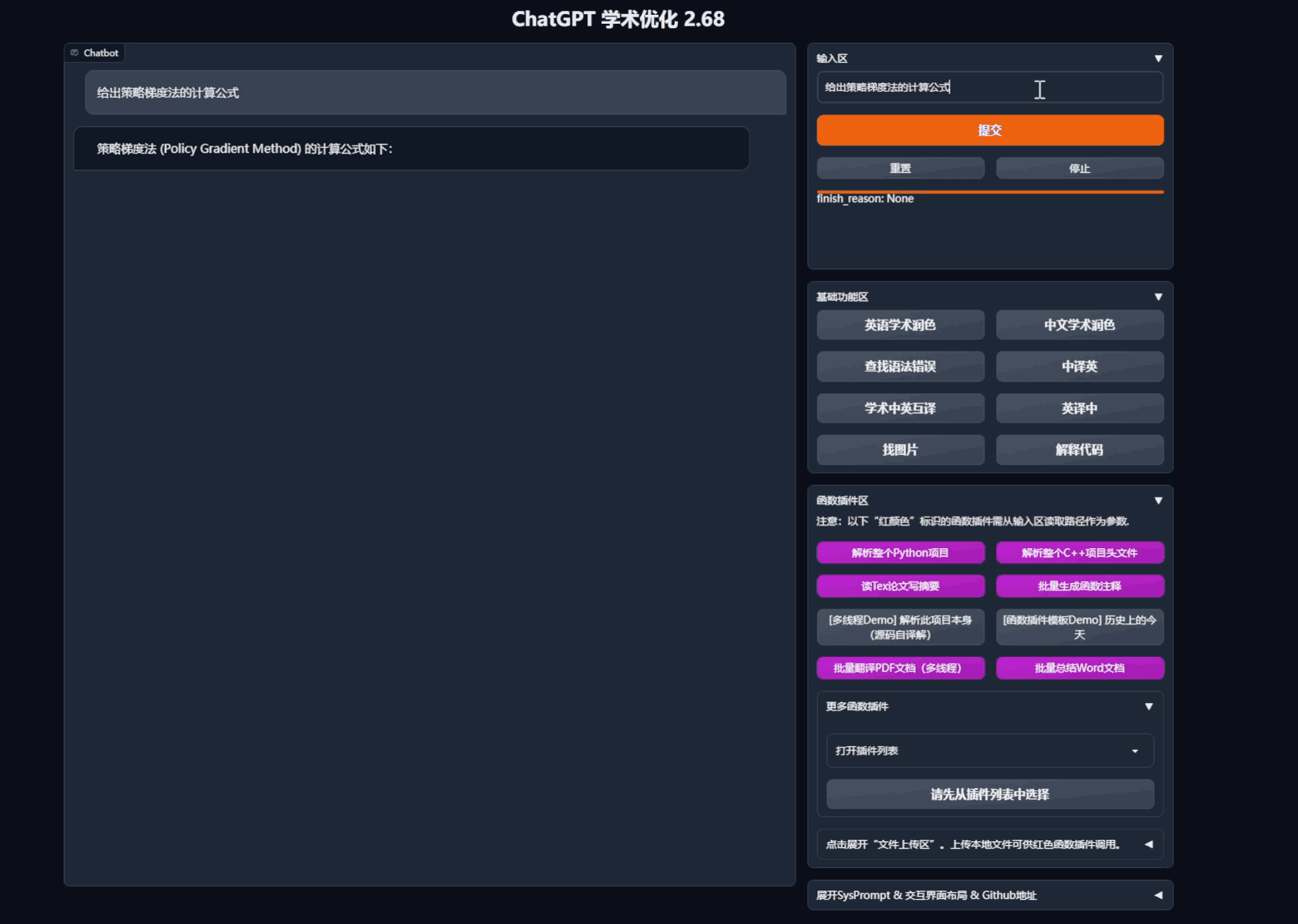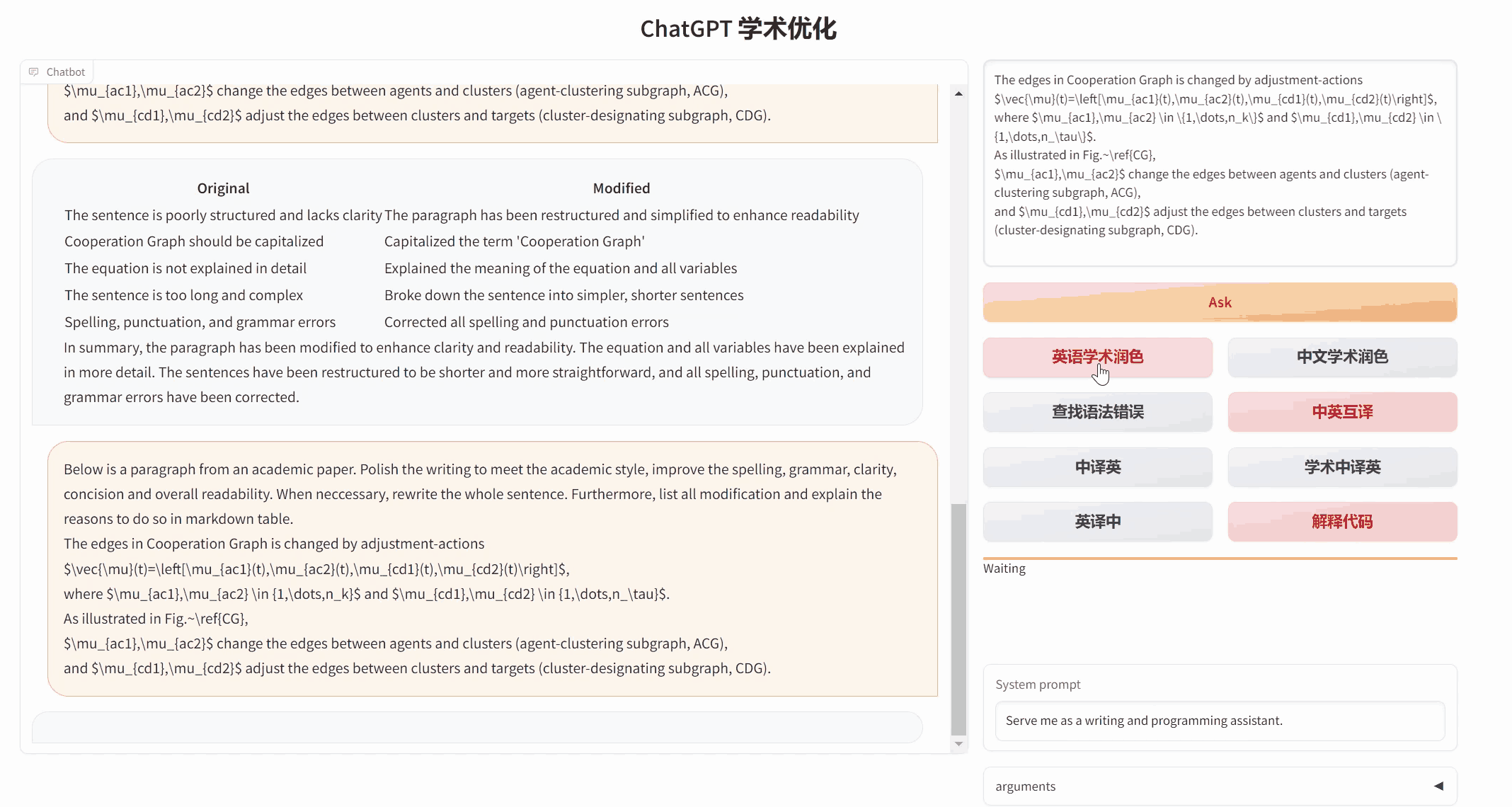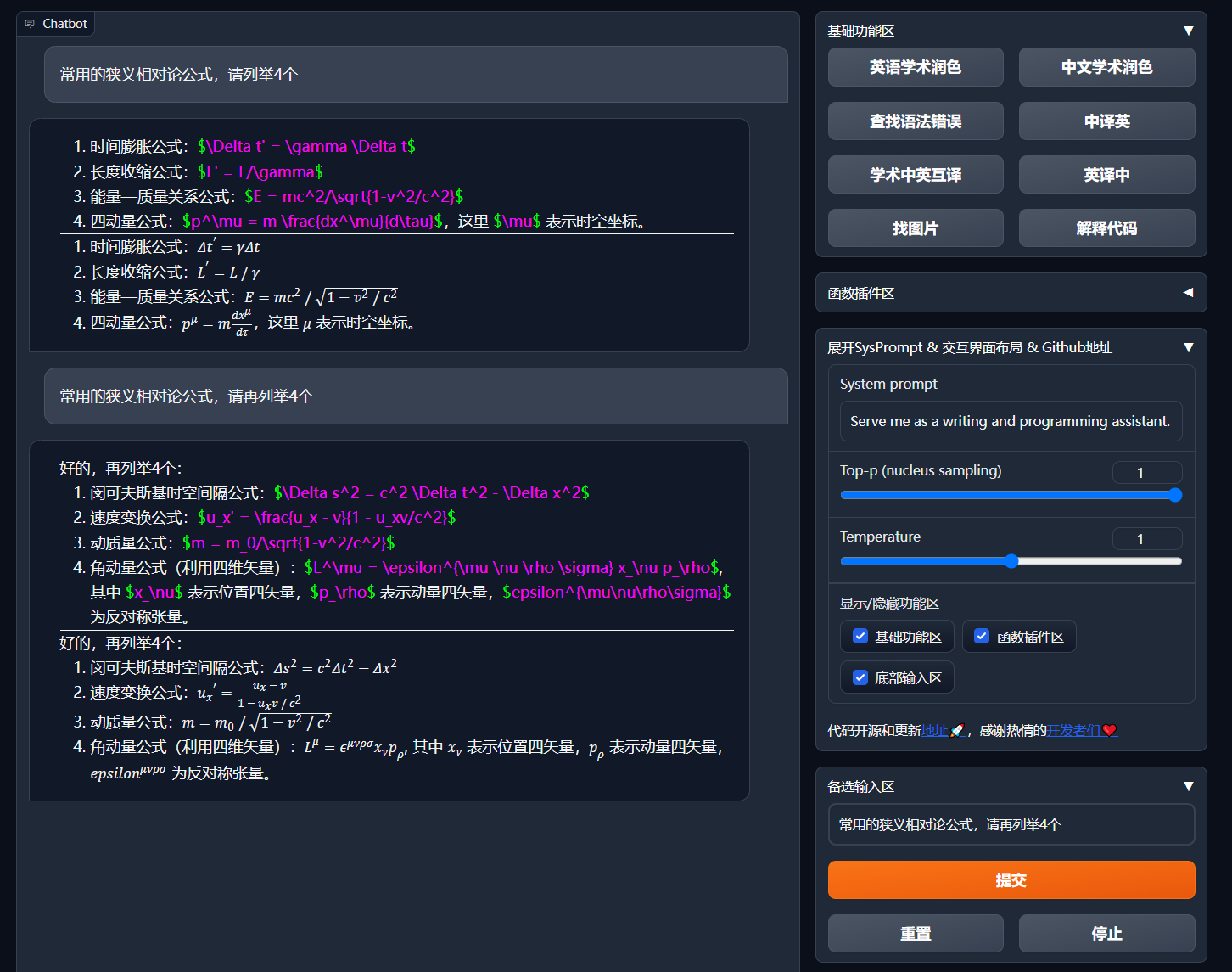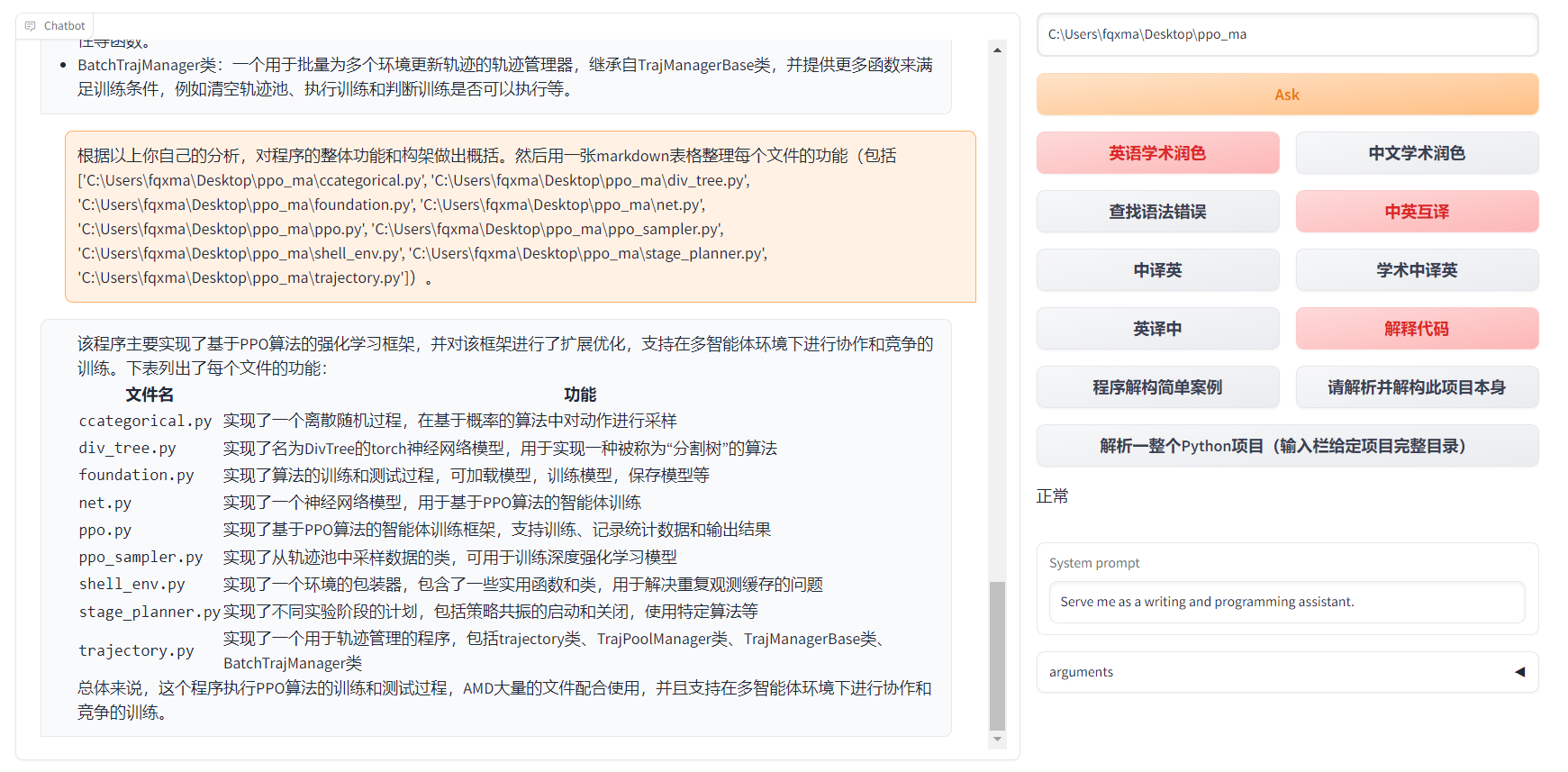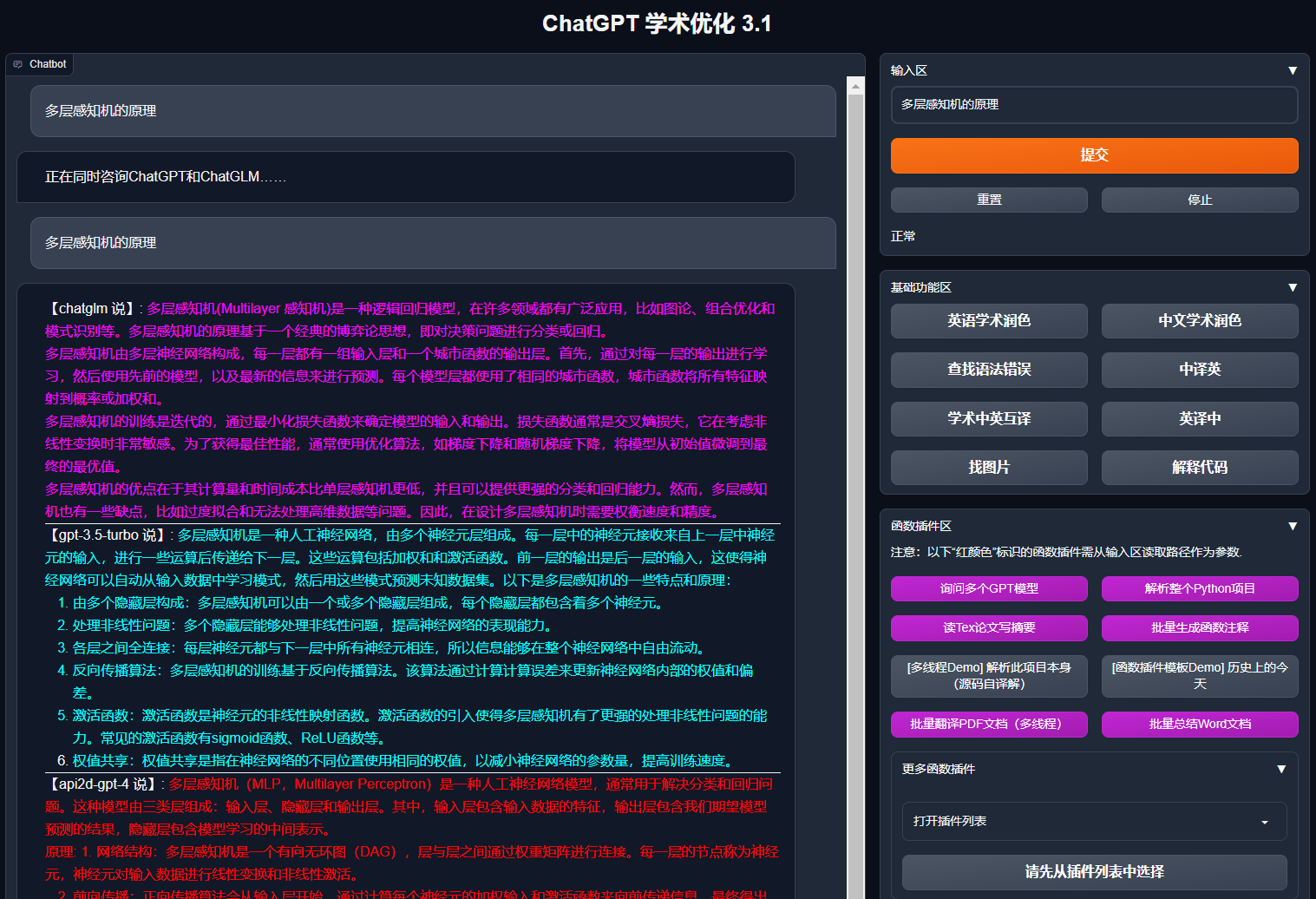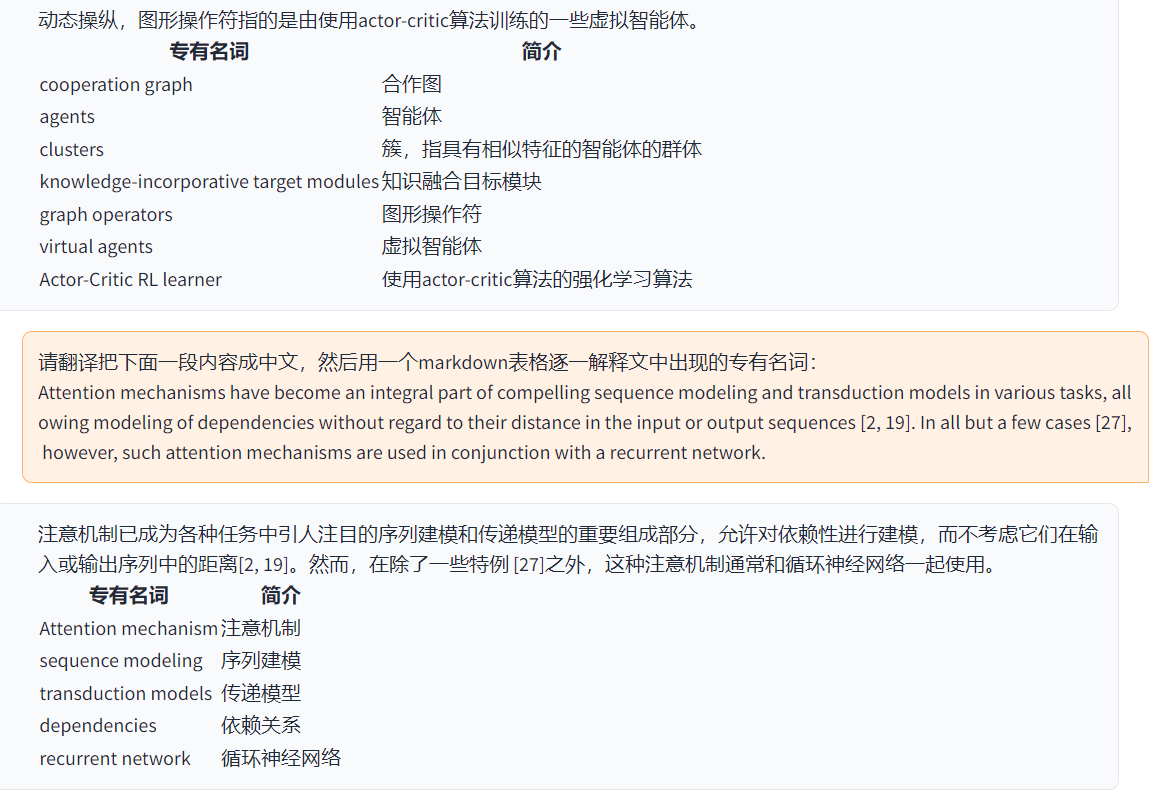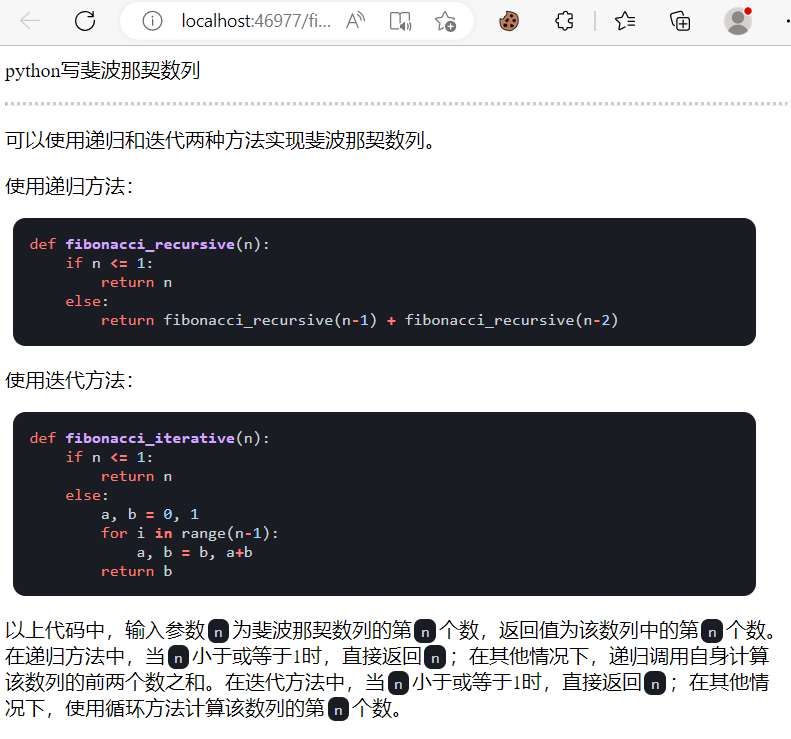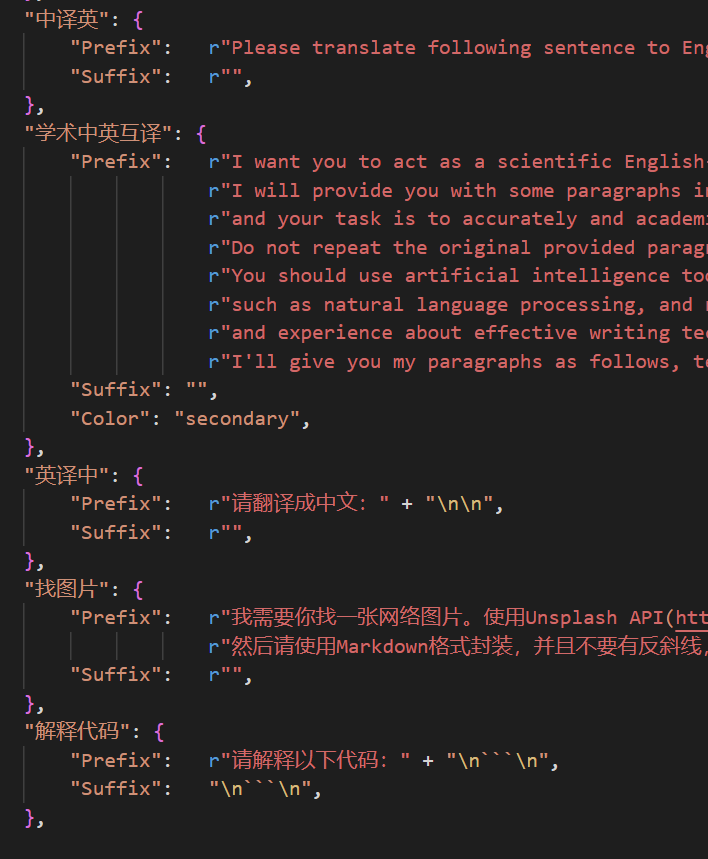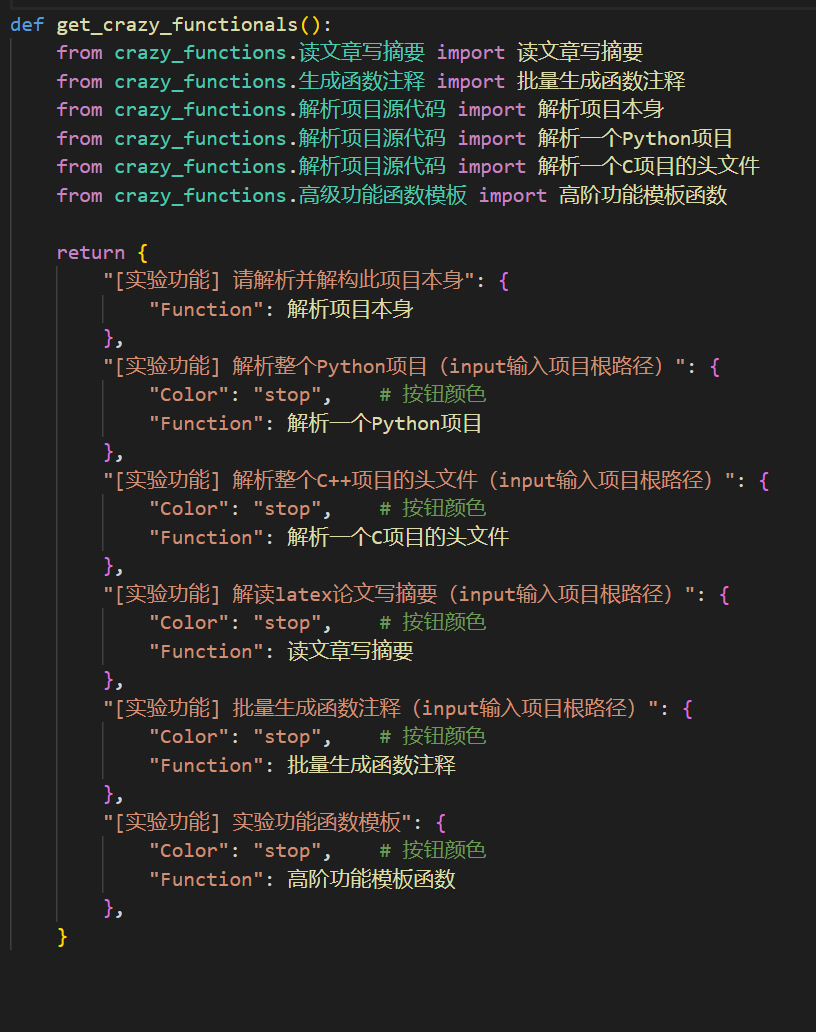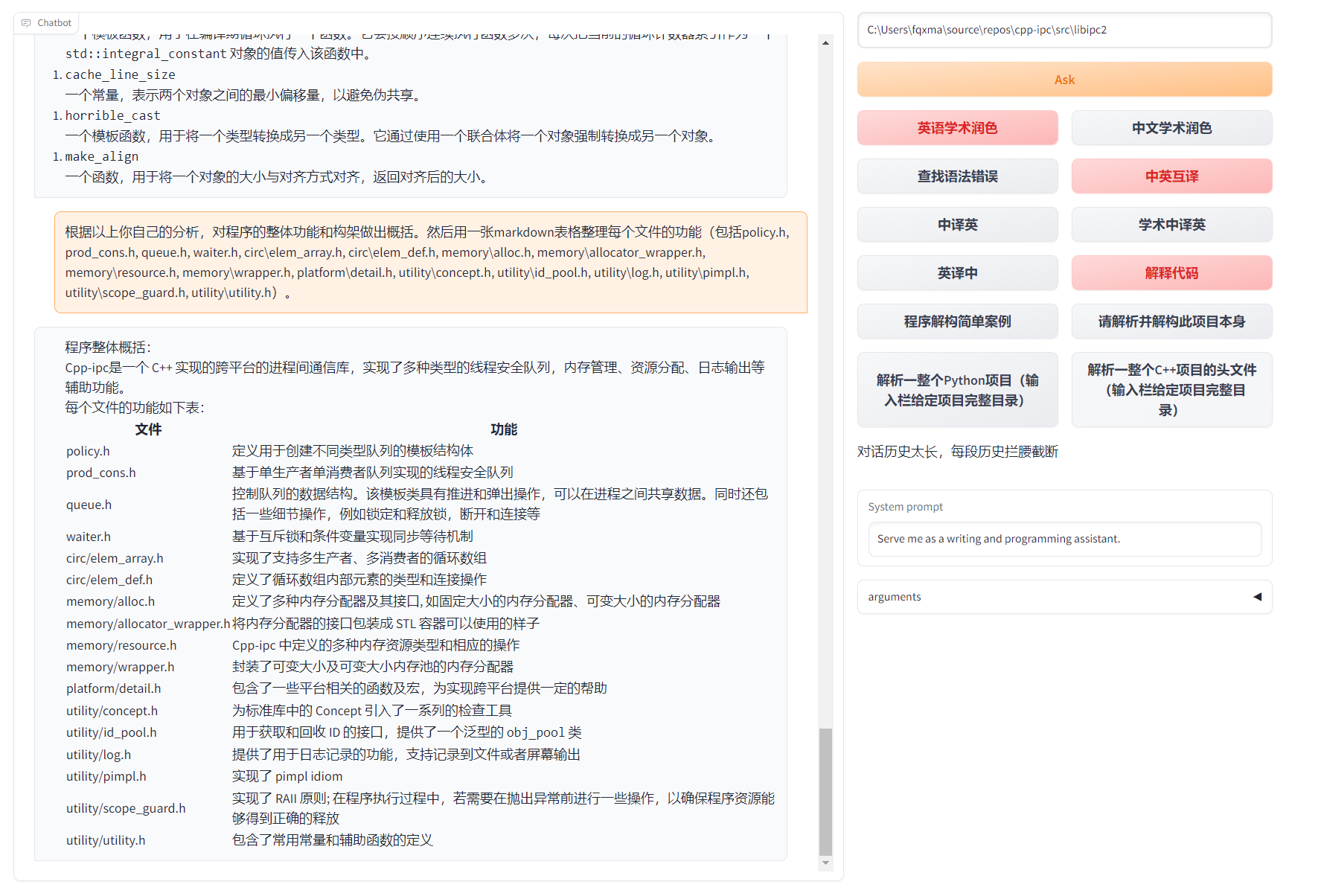
gpt_academic
为GPT/GLM等LLM大语言模型提供实用化交互接口,特别优化论文阅读/润色/写作体验,模块化设计,支持自定义快捷按钮&函数插件,支持Python和C++等项目剖析&自译解功能,PDF/LaTex论文翻译&总结功能,支持并行问询多种LLM模型,支持chatglm3等本地模型。接入通义千问, deepseekcoder, 讯飞星火, 文心一言, llama2, rwkv, claude2, moss等。
Stars: 69232
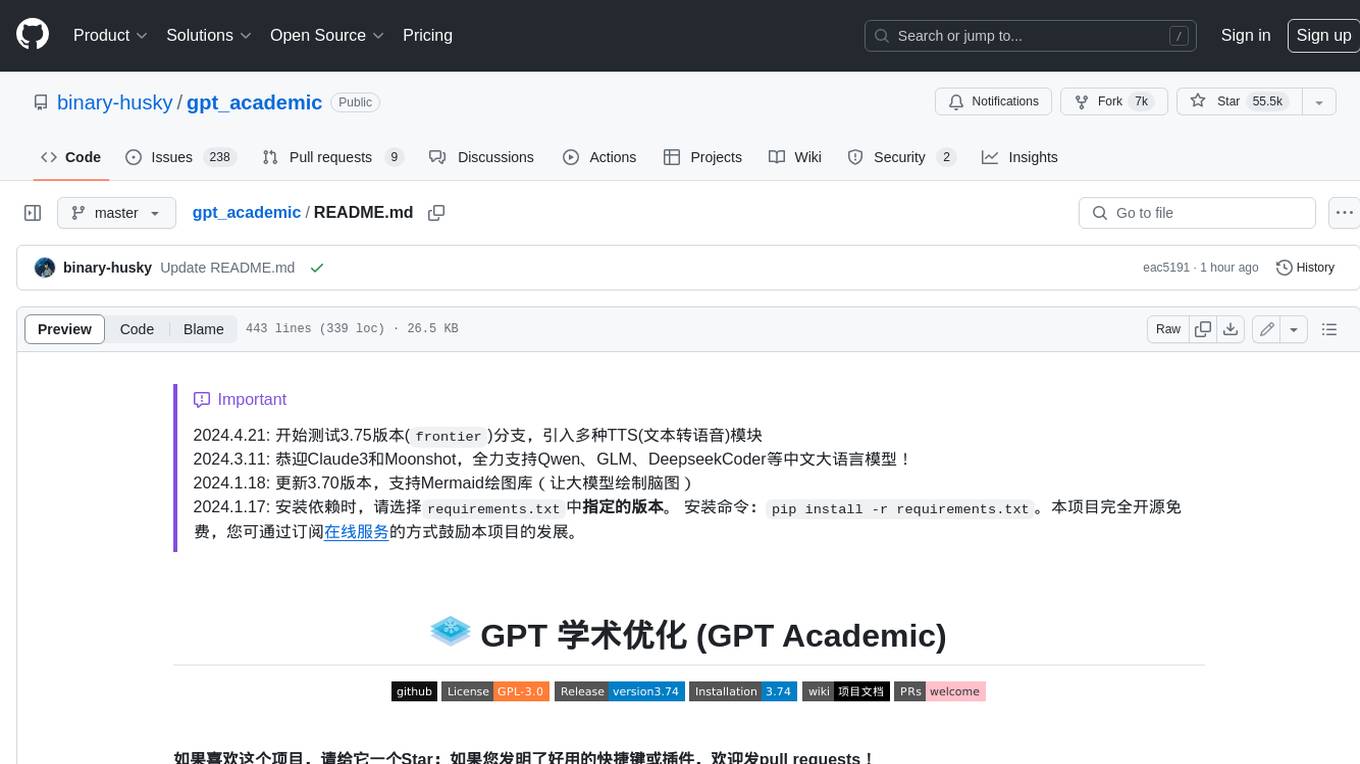
GPT Academic is a powerful tool that leverages the capabilities of large language models (LLMs) to enhance academic research and writing. It provides a user-friendly interface that allows researchers, students, and professionals to interact with LLMs and utilize their abilities for various academic tasks. With GPT Academic, users can access a wide range of features and functionalities, including: * **Summarization and Paraphrasing:** GPT Academic can summarize complex texts, articles, and research papers into concise and informative summaries. It can also paraphrase text to improve clarity and readability. * **Question Answering:** Users can ask GPT Academic questions related to their research or studies, and the tool will provide comprehensive and well-informed answers based on its knowledge and understanding of the relevant literature. * **Code Generation and Explanation:** GPT Academic can generate code snippets and provide explanations for complex coding concepts. It can also help debug code and suggest improvements. * **Translation:** GPT Academic supports translation of text between multiple languages, making it a valuable tool for researchers working with international collaborations or accessing resources in different languages. * **Citation and Reference Management:** GPT Academic can help users manage their citations and references by automatically generating citations in various formats and providing suggestions for relevant references based on the user's research topic. * **Collaboration and Note-Taking:** GPT Academic allows users to collaborate on projects and take notes within the tool. They can share their work with others and access a shared workspace for real-time collaboration. * **Customizable Interface:** GPT Academic offers a customizable interface that allows users to tailor the tool to their specific needs and preferences. They can choose from a variety of themes, adjust the layout, and add or remove features to create a personalized workspace. Overall, GPT Academic is a versatile and powerful tool that can significantly enhance the productivity and efficiency of academic research and writing. It empowers users to leverage the capabilities of LLMs and unlock new possibilities for academic exploration and knowledge creation.
README:
[!IMPORTANT]
master主分支最新动态(2025.8.23): Dockerfile构建效率大幅优化master主分支最新动态(2025.7.31): 新GUI前端,Coming Soon2025.2.2: 三分钟快速接入最强qwen2.5-max视频 2025.2.1: 支持自定义字体 2024.10.10: 突发停电,紧急恢复了提供whl包的文件服务器 2024.5.1: 加入Doc2x翻译PDF论文的功能,查看详情 2024.3.11: 全力支持Qwen、GLM、DeepseekCoder等中文大语言模型! SoVits语音克隆模块,查看详情 2024.1.17: 安装依赖时,请选择
requirements.txt中指定的版本。 安装命令:pip install -r requirements.txt。
如果喜欢这个项目,请给它一个Star;如果您发明了好用的快捷键或插件,欢迎发pull requests!
If you like this project, please give it a Star.
Read this in English | 日本語 | 한국어 | Русский | Français. All translations have been provided by the project itself. To translate this project to arbitrary language with GPT, read and run multi_language.py (experimental).
[!NOTE] 1.本项目中每个文件的功能都在自译解报告
self_analysis.md详细说明。随着版本的迭代,您也可以随时自行点击相关函数插件,调用GPT重新生成项目的自我解析报告。常见问题请查阅wiki。


2.本项目兼容并鼓励尝试国内中文大语言基座模型如通义千问,智谱GLM等。支持多个api-key共存,可在配置文件中填写如
API_KEY="openai-key1,openai-key2,azure-key3,api2d-key4"。需要临时更换API_KEY时,在输入区输入临时的API_KEY然后回车键提交即可生效。
| 功能(⭐= 近期新增功能) | 描述 |
|---|---|
| ⭐接入新模型 | 百度千帆与文心一言, 通义千问Qwen,上海AI-Lab书生,讯飞星火,LLaMa2,智谱GLM4,DALLE3, DeepseekCoder |
| ⭐支持mermaid图像渲染 | 支持让GPT生成流程图、状态转移图、甘特图、饼状图、GitGraph等等(3.7版本) |
| ⭐Arxiv论文精细翻译 (Docker) | [插件] 一键以超高质量翻译arxiv论文,目前最好的论文翻译工具 |
| ⭐实时语音对话输入 | [插件] 异步监听音频,自动断句,自动寻找回答时机 |
| ⭐虚空终端插件 | [插件] 能够使用自然语言直接调度本项目其他插件 |
| 润色、翻译、代码解释 | 一键润色、翻译、查找论文语法错误、解释代码 |
| 自定义快捷键 | 支持自定义快捷键 |
| 模块化设计 | 支持自定义强大的插件,插件支持热更新 |
| 程序剖析 | [插件] 一键剖析Python/C/C++/Java/Lua/...项目树 或 自我剖析 |
| 读论文、翻译论文 | [插件] 一键解读latex/pdf论文全文并生成摘要 |
| Latex全文翻译、润色 | [插件] 一键翻译或润色latex论文 |
| 批量注释生成 | [插件] 一键批量生成函数注释 |
| Markdown中英互译 | [插件] 看到上面5种语言的README了吗?就是出自他的手笔 |
| PDF论文全文翻译功能 | [插件] PDF论文提取题目&摘要+翻译全文(多线程) |
| Arxiv小助手 | [插件] 输入arxiv文章url即可一键翻译摘要+下载PDF |
| Latex论文一键校对 | [插件] 仿Grammarly对Latex文章进行语法、拼写纠错+输出对照PDF |
| 谷歌学术统合小助手 | [插件] 给定任意谷歌学术搜索页面URL,让gpt帮你写relatedworks |
| 互联网信息聚合+GPT | [插件] 一键让GPT从互联网获取信息回答问题,让信息永不过时 |
| 公式/图片/表格显示 | 可以同时显示公式的tex形式和渲染形式,支持公式、代码高亮 |
| 启动暗色主题 | 在浏览器url后面添加/?__theme=dark可以切换dark主题 |
| 多LLM模型支持 | 同时被GPT3.5、GPT4、清华ChatGLM2、复旦MOSS伺候的感觉一定会很不错吧? |
| 更多LLM模型接入,支持huggingface部署 | 加入Newbing接口(新必应),引入清华Jittorllms支持LLaMA和盘古α |
| ⭐void-terminal pip包 | 脱离GUI,在Python中直接调用本项目的所有函数插件(开发中) |
| 更多新功能展示 (图像生成等) …… | 见本文档结尾处 …… |
- 新界面(修改
config.py中的LAYOUT选项即可实现“左右布局”和“上下布局”的切换)
- 所有按钮都通过读取functional.py动态生成,可随意加自定义功能,解放剪贴板
- 润色/纠错
- 如果输出包含公式,会以tex形式和渲染形式同时显示,方便复制和阅读
- 懒得看项目代码?直接把整个工程炫ChatGPT嘴里
- 多种大语言模型混合调用(ChatGLM + OpenAI-GPT3.5 + GPT4)
flowchart TD
A{"安装方法"} --> W1("I 🔑直接运行 (Windows, Linux or MacOS)")
W1 --> W11["1 Python pip包管理依赖"]
W1 --> W12["2 Anaconda包管理依赖(推荐⭐)"]
A --> W2["II 🐳使用Docker (Windows, Linux or MacOS)"]
W2 --> k1["1 部署项目全部能力的大镜像(推荐⭐)"]
W2 --> k2["2 仅在线模型(GPT, GLM4等)镜像"]
W2 --> k3["3 在线模型 + Latex的大镜像"]
A --> W4["IV 🚀其他部署方法"]
W4 --> C1["1 Windows/MacOS 一键安装运行脚本(推荐⭐)"]
W4 --> C2["2 Huggingface, Sealos远程部署"]
W4 --> C4["3 其他 ..."]-
下载项目
git clone --depth=1 https://github.com/binary-husky/gpt_academic.git cd gpt_academic -
配置API_KEY等变量
在
config.py中,配置API KEY等变量。特殊网络环境设置方法、Wiki-项目配置说明。「 程序会优先检查是否存在名为
config_private.py的私密配置文件,并用其中的配置覆盖config.py的同名配置。如您能理解以上读取逻辑,我们强烈建议您在config.py同路径下创建一个名为config_private.py的新配置文件,并使用config_private.py配置项目,从而确保自动更新时不会丢失配置 」。「 支持通过
环境变量配置项目,环境变量的书写格式参考docker-compose.yml文件或者我们的Wiki页面。配置读取优先级:环境变量>config_private.py>config.py」。 -
安装依赖
# (选择I: 如熟悉python, python推荐版本 3.9 ~ 3.11)备注:使用官方pip源或者阿里pip源, 临时换源方法:python -m pip install -r requirements.txt -i https://mirrors.aliyun.com/pypi/simple/ python -m pip install -r requirements.txt # (选择II: 使用Anaconda)步骤也是类似的 (https://www.bilibili.com/video/BV1rc411W7Dr): conda create -n gptac_venv python=3.11 # 创建anaconda环境 conda activate gptac_venv # 激活anaconda环境 python -m pip install -r requirements.txt # 这个步骤和pip安装一样的步骤 # (选择III: 使用uv): uv venv --python=3.11 # 创建虚拟环境 source ./.venv/bin/activate # 激活虚拟环境 uv pip install --verbose -r requirements.txt -i https://mirrors.aliyun.com/pypi/simple/ # 安装依赖
如果需要支持清华ChatGLM系列/复旦MOSS/RWKV作为后端,请点击展开此处
【可选步骤】如果需要支持清华ChatGLM系列/复旦MOSS作为后端,需要额外安装更多依赖(前提条件:熟悉Python + 用过Pytorch + 电脑配置够强):
# 【可选步骤I】支持清华ChatGLM3。清华ChatGLM备注:如果遇到"Call ChatGLM fail 不能正常加载ChatGLM的参数" 错误,参考如下: 1:以上默认安装的为torch+cpu版,使用cuda需要卸载torch重新安装torch+cuda; 2:如因本机配置不够无法加载模型,可以修改request_llm/bridge_chatglm.py中的模型精度, 将 AutoTokenizer.from_pretrained("THUDM/chatglm-6b", trust_remote_code=True) 都修改为 AutoTokenizer.from_pretrained("THUDM/chatglm-6b-int4", trust_remote_code=True)
python -m pip install -r request_llms/requirements_chatglm.txt
# 【可选步骤II】支持清华ChatGLM4 注意:此模型至少需要24G显存
python -m pip install -r request_llms/requirements_chatglm4.txt
# 可使用modelscope下载ChatGLM4模型
# pip install modelscope
# modelscope download --model ZhipuAI/glm-4-9b-chat --local_dir ./THUDM/glm-4-9b-chat
# 【可选步骤III】支持复旦MOSS
python -m pip install -r request_llms/requirements_moss.txt
git clone --depth=1 https://github.com/OpenLMLab/MOSS.git request_llms/moss # 注意执行此行代码时,必须处于项目根路径
# 【可选步骤IV】支持RWKV Runner
参考wiki:https://github.com/binary-husky/gpt_academic/wiki/%E9%80%82%E9%85%8DRWKV-Runner
# 【可选步骤V】确保config.py配置文件的AVAIL_LLM_MODELS包含了期望的模型,目前支持的全部模型如下(jittorllms系列目前仅支持docker方案):
AVAIL_LLM_MODELS = ["gpt-3.5-turbo", "api2d-gpt-3.5-turbo", "gpt-4", "api2d-gpt-4", "chatglm", "moss"] # + ["jittorllms_rwkv", "jittorllms_pangualpha", "jittorllms_llama"]
# 【可选步骤VI】支持本地模型INT8,INT4量化(这里所指的模型本身不是量化版本,目前deepseek-coder支持,后面测试后会加入更多模型量化选择)
pip install bitsandbyte
# windows用户安装bitsandbytes需要使用下面bitsandbytes-windows-webui
python -m pip install bitsandbytes --prefer-binary --extra-index-url=https://jllllll.github.io/bitsandbytes-windows-webui
pip install -U git+https://github.com/huggingface/transformers.git
pip install -U git+https://github.com/huggingface/accelerate.git
pip install peft- 运行
python main.py
-
部署项目的全部能力(这个是包含cuda和latex的大型镜像。但如果您网速慢、硬盘小,则不推荐该方法部署完整项目)
# 修改docker-compose.yml,保留方案0并删除其他方案。然后运行: docker-compose up -
仅ChatGPT + GLM4 + 文心一言+spark等在线模型(推荐大多数人选择)
# 修改docker-compose.yml,保留方案1并删除其他方案。然后运行: docker-compose up
P.S. 如果需要依赖Latex的插件功能,请见Wiki。另外,您也可以直接使用方案4或者方案0获取Latex功能。
-
ChatGPT + GLM3 + MOSS + LLAMA2 + 通义千问(需要熟悉Nvidia Docker运行时)
# 修改docker-compose.yml,保留方案2并删除其他方案。然后运行: docker-compose up
-
Windows一键运行脚本。 完全不熟悉python环境的Windows用户可以下载Release中发布的一键运行脚本安装无本地模型的版本。脚本贡献来源:oobabooga。
-
使用第三方API、Azure等、文心一言、星火等,见Wiki页面
-
云服务器远程部署避坑指南。 请访问云服务器远程部署wiki
-
在其他平台部署&二级网址部署
- 使用Sealos一键部署。
- 使用WSL2(Windows Subsystem for Linux 子系统)。请访问部署wiki-2
- 如何在二级网址(如
http://localhost/subpath)下运行。请访问FastAPI运行说明
现在已可以通过UI中的界面外观菜单中的自定义菜单添加新的便捷按钮。如果需要在代码中定义,请使用任意文本编辑器打开core_functional.py,添加如下条目即可:
"超级英译中": {
# 前缀,会被加在你的输入之前。例如,用来描述你的要求,例如翻译、解释代码、润色等等
"Prefix": "请翻译把下面一段内容成中文,然后用一个markdown表格逐一解释文中出现的专有名词:\n\n",
# 后缀,会被加在你的输入之后。例如,配合前缀可以把你的输入内容用引号圈起来。
"Suffix": "",
},编写强大的函数插件来执行任何你想得到的和想不到的任务。 本项目的插件编写、调试难度很低,只要您具备一定的python基础知识,就可以仿照我们提供的模板实现自己的插件功能。 详情请参考函数插件指南。
- 对话保存功能。在函数插件区调用
保存当前的对话即可将当前对话保存为可读+可复原的html文件, 另外在函数插件区(下拉菜单)调用载入对话历史存档,即可还原之前的会话。 Tip:不指定文件直接点击载入对话历史存档可以查看历史html存档缓存。
- ⭐Latex/Arxiv论文翻译功能⭐
- 虚空终端(从自然语言输入中,理解用户意图+自动调用其他插件)
- 步骤一:输入 “ 请调用插件翻译PDF论文,地址为https://openreview.net/pdf?id=rJl0r3R9KX ”
- 步骤二:点击“虚空终端”
- 模块化功能设计,简单的接口却能支持强大的功能
- 译解其他开源项目
- 装饰live2d的小功能(默认关闭,需要修改
config.py)
- OpenAI图像生成
- 基于mermaid的流图、脑图绘制
- Latex全文校对纠错
- 语言、主题切换
- version 3.80(TODO): 优化AutoGen插件主题并设计一系列衍生插件
- version 3.70: 引入Mermaid绘图,实现GPT画脑图等功能
- version 3.60: 引入AutoGen作为新一代插件的基石
- version 3.57: 支持GLM3,星火v3,文心一言v4,修复本地模型的并发BUG
- version 3.56: 支持动态追加基础功能按钮,新汇报PDF汇总页面
- version 3.55: 重构前端界面,引入悬浮窗口与菜单栏
- version 3.54: 新增动态代码解释器(Code Interpreter)(待完善)
- version 3.53: 支持动态选择不同界面主题,提高稳定性&解决多用户冲突问题
- version 3.50: 使用自然语言调用本项目的所有函数插件(虚空终端),支持插件分类,改进UI,设计新主题
- version 3.49: 支持百度千帆平台和文心一言
- version 3.48: 支持阿里达摩院通义千问,上海AI-Lab书生,讯飞星火
- version 3.46: 支持完全脱手操作的实时语音对话
- version 3.45: 支持自定义ChatGLM2微调模型
- version 3.44: 正式支持Azure,优化界面易用性
- version 3.4: +arxiv论文翻译、latex论文批改功能
- version 3.3: +互联网信息综合功能
- version 3.2: 函数插件支持更多参数接口 (保存对话功能, 解读任意语言代码+同时询问任意的LLM组合)
- version 3.1: 支持同时问询多个gpt模型!支持api2d,支持多个apikey负载均衡
- version 3.0: 对chatglm和其他小型llm的支持
- version 2.6: 重构了插件结构,提高了交互性,加入更多插件
- version 2.5: 自更新,解决总结大工程源代码时文本过长、token溢出的问题
- version 2.4: 新增PDF全文翻译功能; 新增输入区切换位置的功能
- version 2.3: 增强多线程交互性
- version 2.2: 函数插件支持热重载
- version 2.1: 可折叠式布局
- version 2.0: 引入模块化函数插件
- version 1.0: 基础功能
GPT Academic开发者QQ群:610599535
- 已知问题
- 某些浏览器翻译插件干扰此软件前端的运行
- 官方Gradio目前有很多兼容性问题,请务必使用
requirement.txt安装Gradio
timeline LR
title GPT-Academic项目发展历程
section 2.x
1.0~2.2: 基础功能: 引入模块化函数插件: 可折叠式布局: 函数插件支持热重载
2.3~2.5: 增强多线程交互性: 新增PDF全文翻译功能: 新增输入区切换位置的功能: 自更新
2.6: 重构了插件结构: 提高了交互性: 加入更多插件
section 3.x
3.0~3.1: 对chatglm支持: 对其他小型llm支持: 支持同时问询多个gpt模型: 支持多个apikey负载均衡
3.2~3.3: 函数插件支持更多参数接口: 保存对话功能: 解读任意语言代码: 同时询问任意的LLM组合: 互联网信息综合功能
3.4: 加入arxiv论文翻译: 加入latex论文批改功能
3.44: 正式支持Azure: 优化界面易用性
3.46: 自定义ChatGLM2微调模型: 实时语音对话
3.49: 支持阿里达摩院通义千问: 上海AI-Lab书生: 讯飞星火: 支持百度千帆平台 & 文心一言
3.50: 虚空终端: 支持插件分类: 改进UI: 设计新主题
3.53: 动态选择不同界面主题: 提高稳定性: 解决多用户冲突问题
3.55: 动态代码解释器: 重构前端界面: 引入悬浮窗口与菜单栏
3.56: 动态追加基础功能按钮: 新汇报PDF汇总页面
3.57: GLM3, 星火v3: 支持文心一言v4: 修复本地模型的并发BUG
3.60: 引入AutoGen
3.70: 引入Mermaid绘图: 实现GPT画脑图等功能
3.80(TODO): 优化AutoGen插件主题: 设计衍生插件
可以通过修改THEME选项(config.py)变更主题
-
Chuanhu-Small-and-Beautiful网址
-
master分支: 主分支,稳定版 -
frontier分支: 开发分支,测试版 - 如何接入其他大模型
代码中参考了很多其他优秀项目中的设计,顺序不分先后:
# 清华ChatGLM2-6B:
https://github.com/THUDM/ChatGLM2-6B
# 清华JittorLLMs:
https://github.com/Jittor/JittorLLMs
# ChatPaper:
https://github.com/kaixindelele/ChatPaper
# Edge-GPT:
https://github.com/acheong08/EdgeGPT
# ChuanhuChatGPT:
https://github.com/GaiZhenbiao/ChuanhuChatGPT
# Oobabooga one-click installer:
https://github.com/oobabooga/one-click-installers
# More:
https://github.com/gradio-app/gradio
https://github.com/fghrsh/live2d_demo
For Tasks:
Click tags to check more tools for each tasksFor Jobs:
Alternative AI tools for gpt_academic
Similar Open Source Tools

gpt_academic
GPT Academic is a powerful tool that leverages the capabilities of large language models (LLMs) to enhance academic research and writing. It provides a user-friendly interface that allows researchers, students, and professionals to interact with LLMs and utilize their abilities for various academic tasks. With GPT Academic, users can access a wide range of features and functionalities, including: * **Summarization and Paraphrasing:** GPT Academic can summarize complex texts, articles, and research papers into concise and informative summaries. It can also paraphrase text to improve clarity and readability. * **Question Answering:** Users can ask GPT Academic questions related to their research or studies, and the tool will provide comprehensive and well-informed answers based on its knowledge and understanding of the relevant literature. * **Code Generation and Explanation:** GPT Academic can generate code snippets and provide explanations for complex coding concepts. It can also help debug code and suggest improvements. * **Translation:** GPT Academic supports translation of text between multiple languages, making it a valuable tool for researchers working with international collaborations or accessing resources in different languages. * **Citation and Reference Management:** GPT Academic can help users manage their citations and references by automatically generating citations in various formats and providing suggestions for relevant references based on the user's research topic. * **Collaboration and Note-Taking:** GPT Academic allows users to collaborate on projects and take notes within the tool. They can share their work with others and access a shared workspace for real-time collaboration. * **Customizable Interface:** GPT Academic offers a customizable interface that allows users to tailor the tool to their specific needs and preferences. They can choose from a variety of themes, adjust the layout, and add or remove features to create a personalized workspace. Overall, GPT Academic is a versatile and powerful tool that can significantly enhance the productivity and efficiency of academic research and writing. It empowers users to leverage the capabilities of LLMs and unlock new possibilities for academic exploration and knowledge creation.
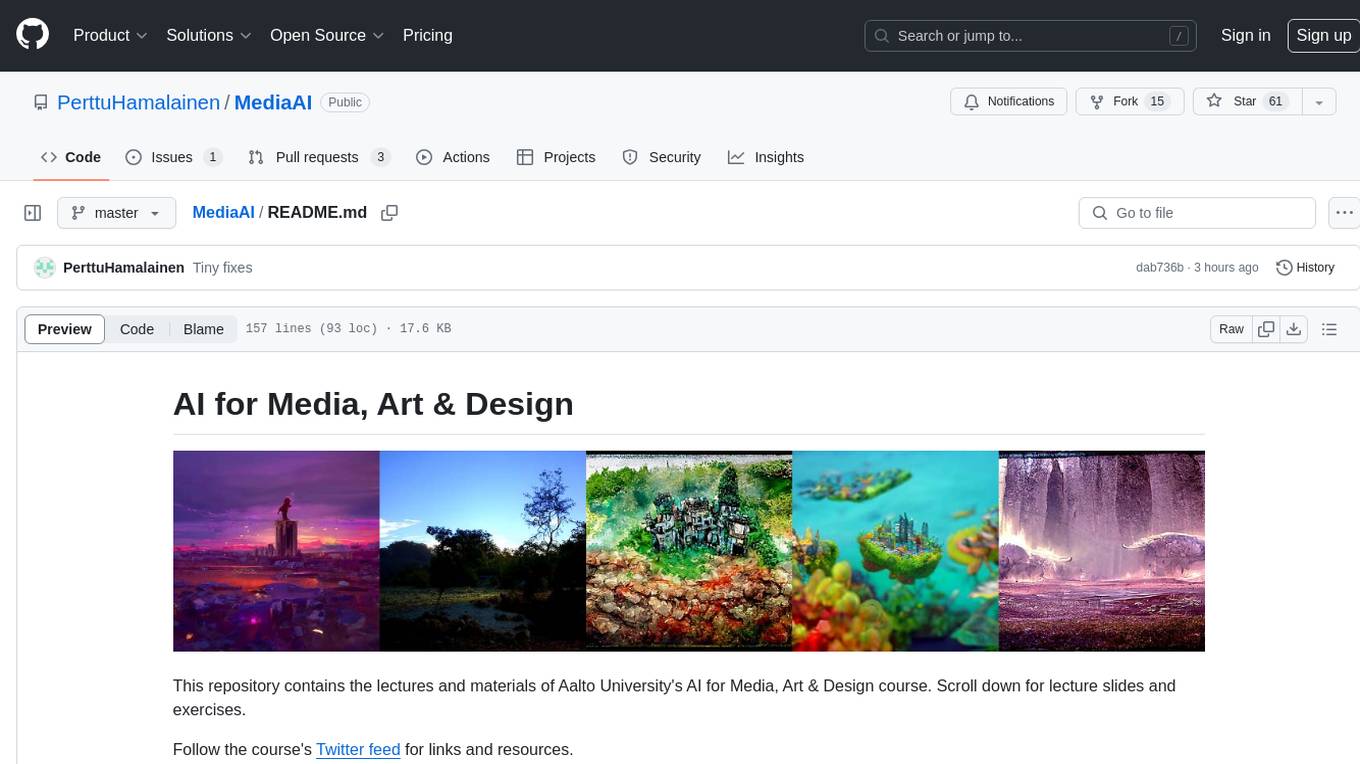
MediaAI
MediaAI is a repository containing lectures and materials for Aalto University's AI for Media, Art & Design course. The course is a hands-on, project-based crash course focusing on deep learning and AI techniques for artists and designers. It covers common AI algorithms & tools, their applications in art, media, and design, and provides hands-on practice in designing, implementing, and using these tools. The course includes lectures, exercises, and a final project based on students' interests. Students can complete the course without programming by creatively utilizing existing tools like ChatGPT and DALL-E. The course emphasizes collaboration, peer-to-peer tutoring, and project-based learning. It covers topics such as text generation, image generation, optimization, and game AI.
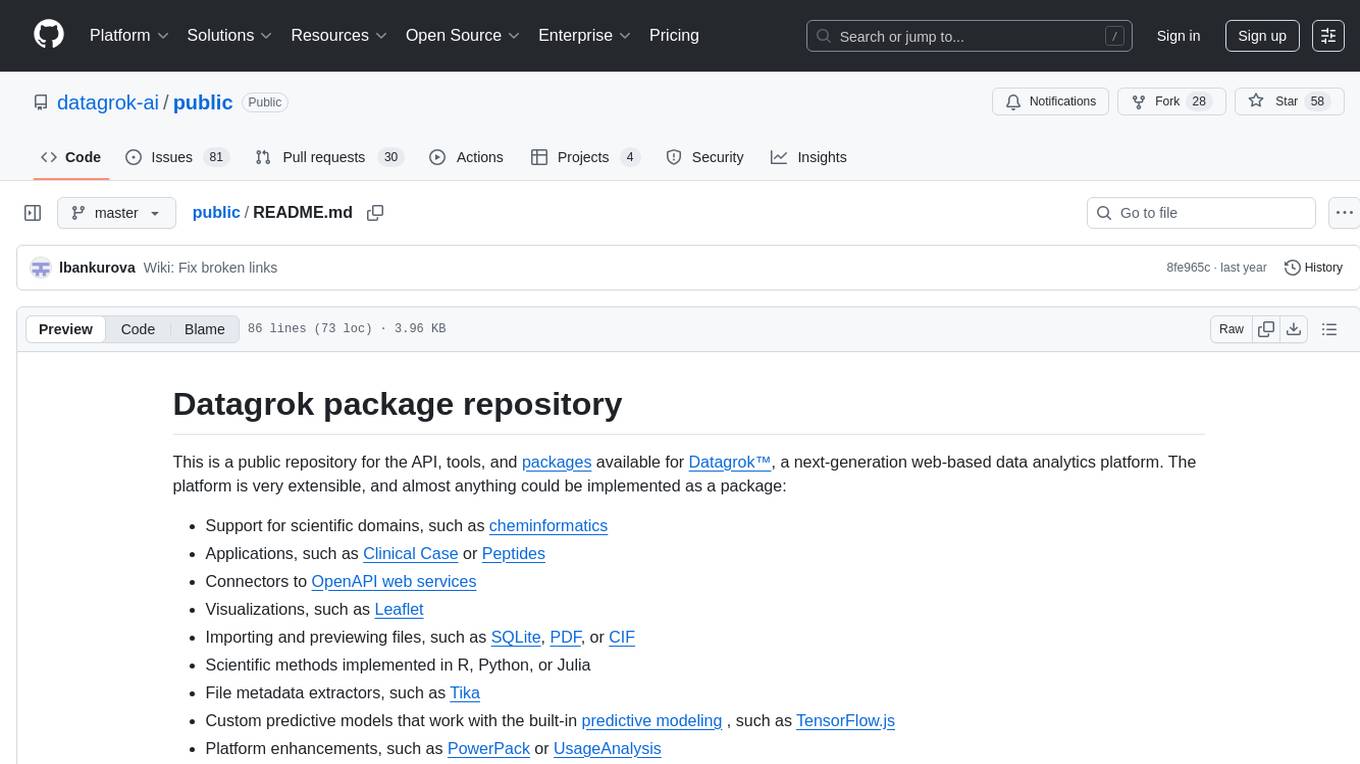
public
This public repository contains API, tools, and packages for Datagrok, a web-based data analytics platform. It offers support for scientific domains, applications, connectors to web services, visualizations, file importing, scientific methods in R, Python, or Julia, file metadata extractors, custom predictive models, platform enhancements, and more. The open-source packages are free to use, with restrictions on server computational capacities for the public environment. Academic institutions can use Datagrok for research and education, benefiting from reproducible and scalable computations and data augmentation capabilities. Developers can contribute by creating visualizations, scientific methods, file editors, connectors to web services, and more.
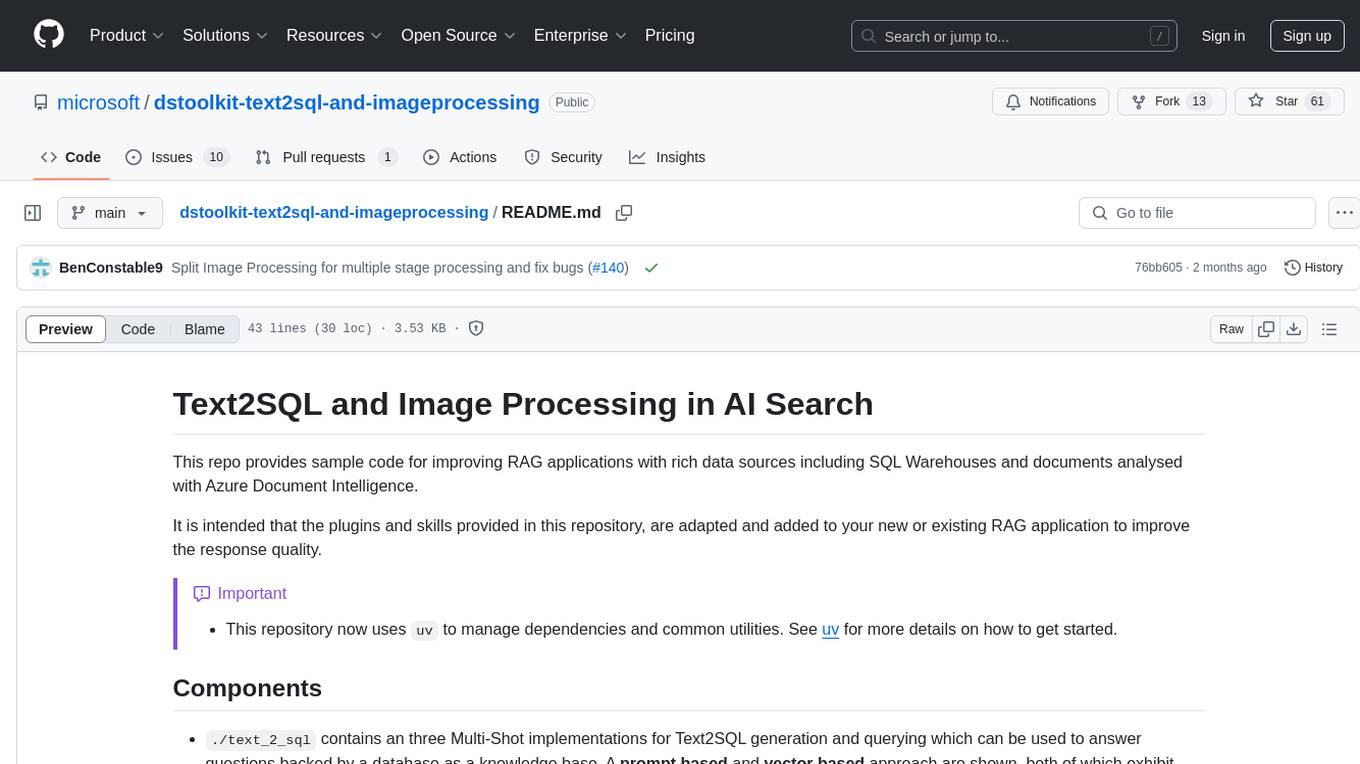
dstoolkit-text2sql-and-imageprocessing
This repository provides sample code for improving RAG applications with rich data sources including SQL Warehouses and documents analysed with Azure Document Intelligence. It includes components for Text2SQL generation and querying, linking Azure Document Intelligence with AI Search for processing complex documents, and deploying AI search indexes. The plugins and skills aim to enhance response quality in RAG applications by accessing and pulling data from SQL tables, drawing insights from complex charts and images, and intelligently grouping similar sentences.
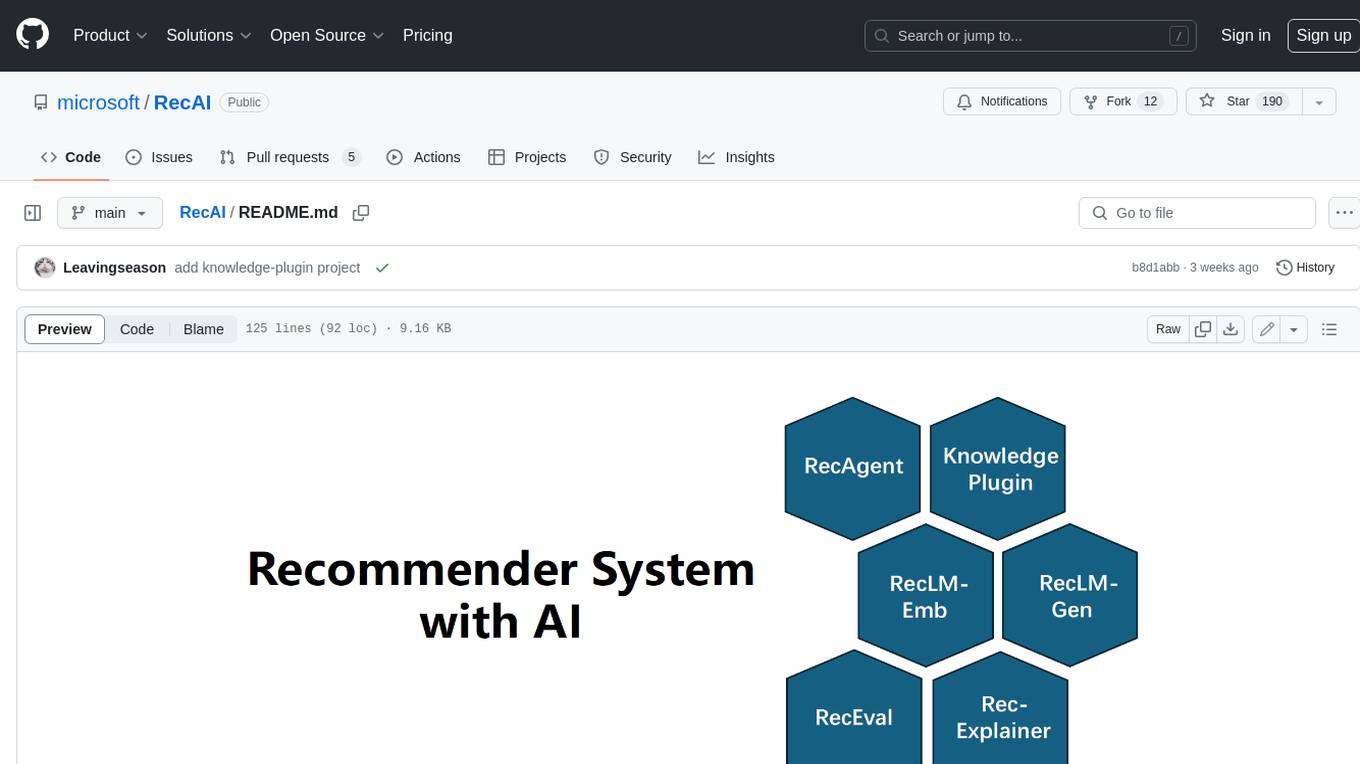
RecAI
RecAI is a project that explores the integration of Large Language Models (LLMs) into recommender systems, addressing the challenges of interactivity, explainability, and controllability. It aims to bridge the gap between general-purpose LLMs and domain-specific recommender systems, providing a holistic perspective on the practical requirements of LLM4Rec. The project investigates various techniques, including Recommender AI agents, selective knowledge injection, fine-tuning language models, evaluation, and LLMs as model explainers, to create more sophisticated, interactive, and user-centric recommender systems.
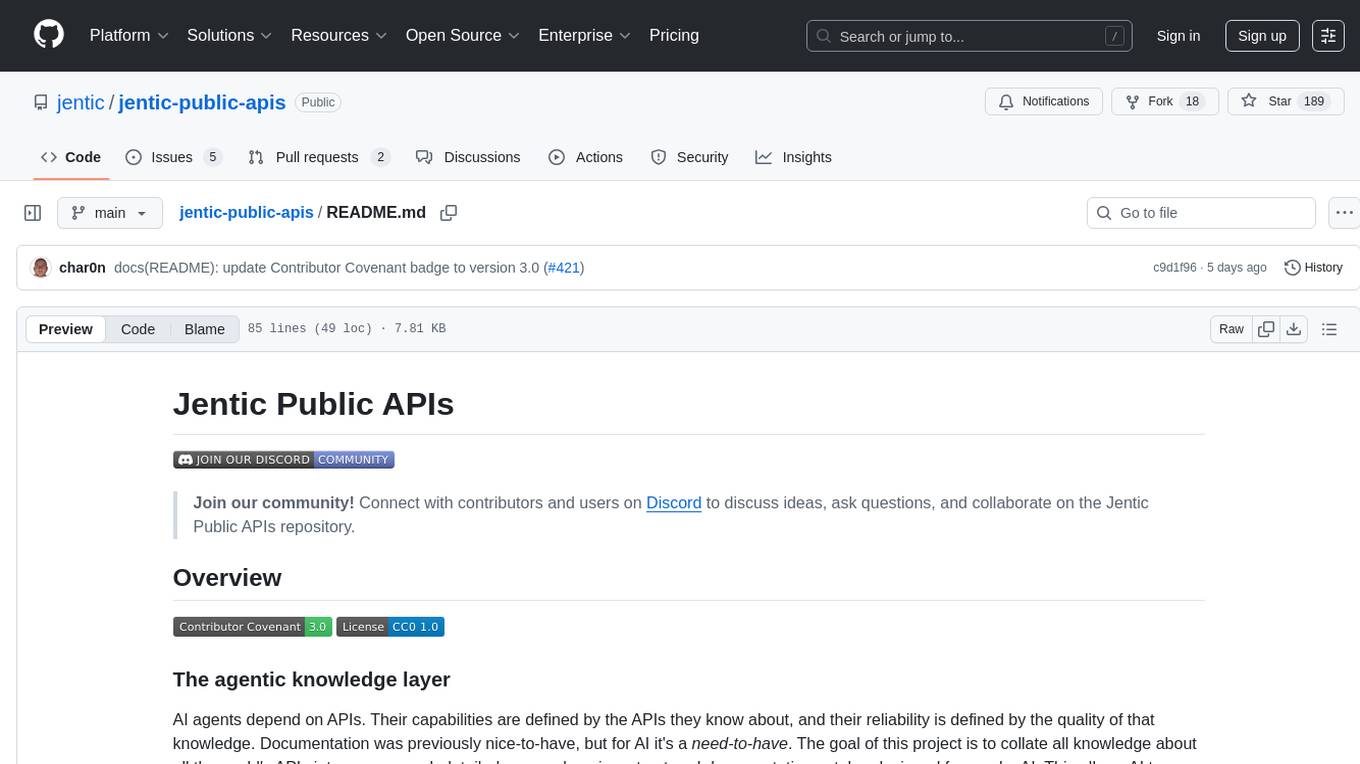
jentic-public-apis
The Jentic Public APIs repository aims to collate all knowledge about the world's APIs into a detailed, comprehensive, structured documentation catalog designed for use by AI. It focuses on standardized OpenAPI specifications, Arazzo workflows, associated tooling, evaluations, and RFCs for extensions to open formats. The project is in ALPHA stage and welcomes contributions to accelerate the effort of building an open knowledge foundation for AI agents.
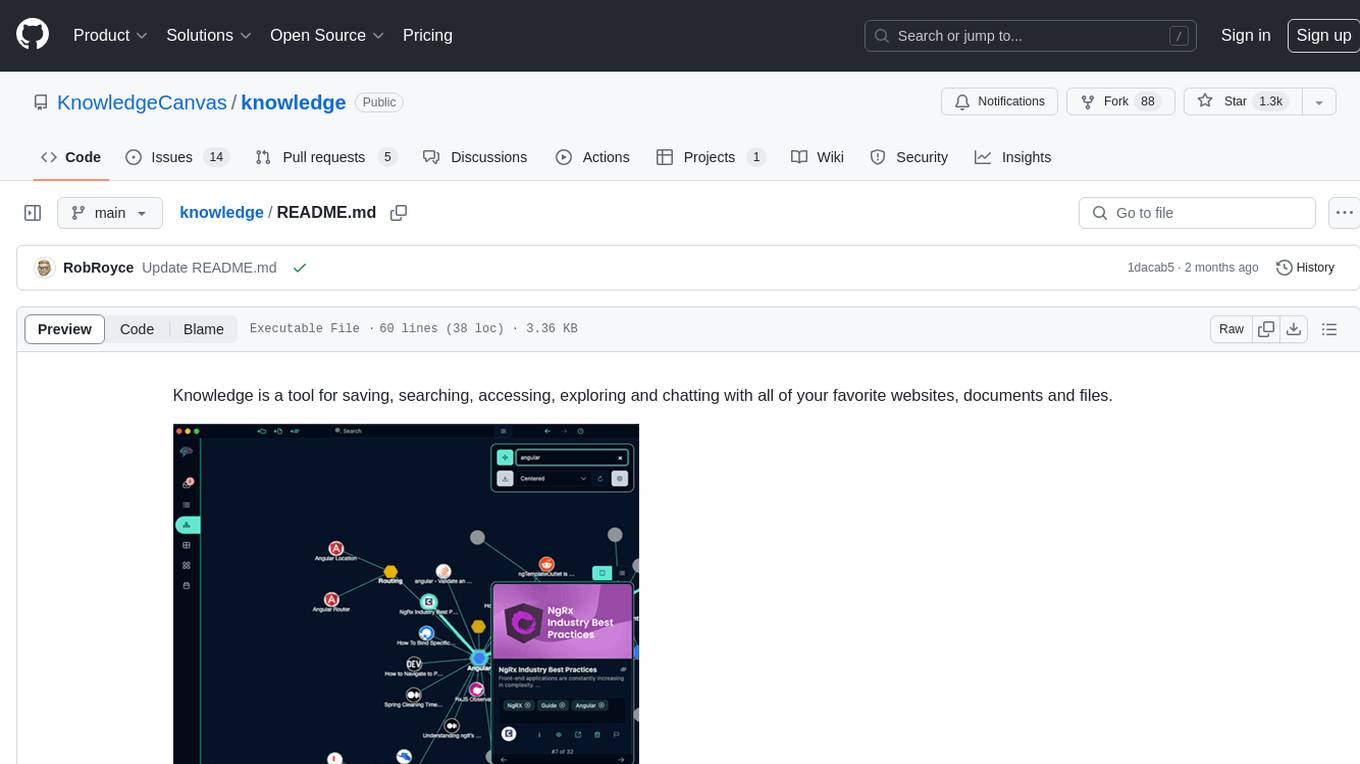
knowledge
Knowledge is a tool for saving, searching, accessing, exploring and chatting with all of your favorite websites, documents and files. Dive into a more interactive learning experience with Knowledge's new Chat feature! Engage in dynamic conversations with your Projects and Sources, leveraging the power of Large Language Models. The Chat feature is designed to transform the way you interact with your data, offering a more engaging and exploratory approach to learning. Unleash the power of context with the built-in Chromium browser. Transform your browsing into knowledge gathering effortlessly.
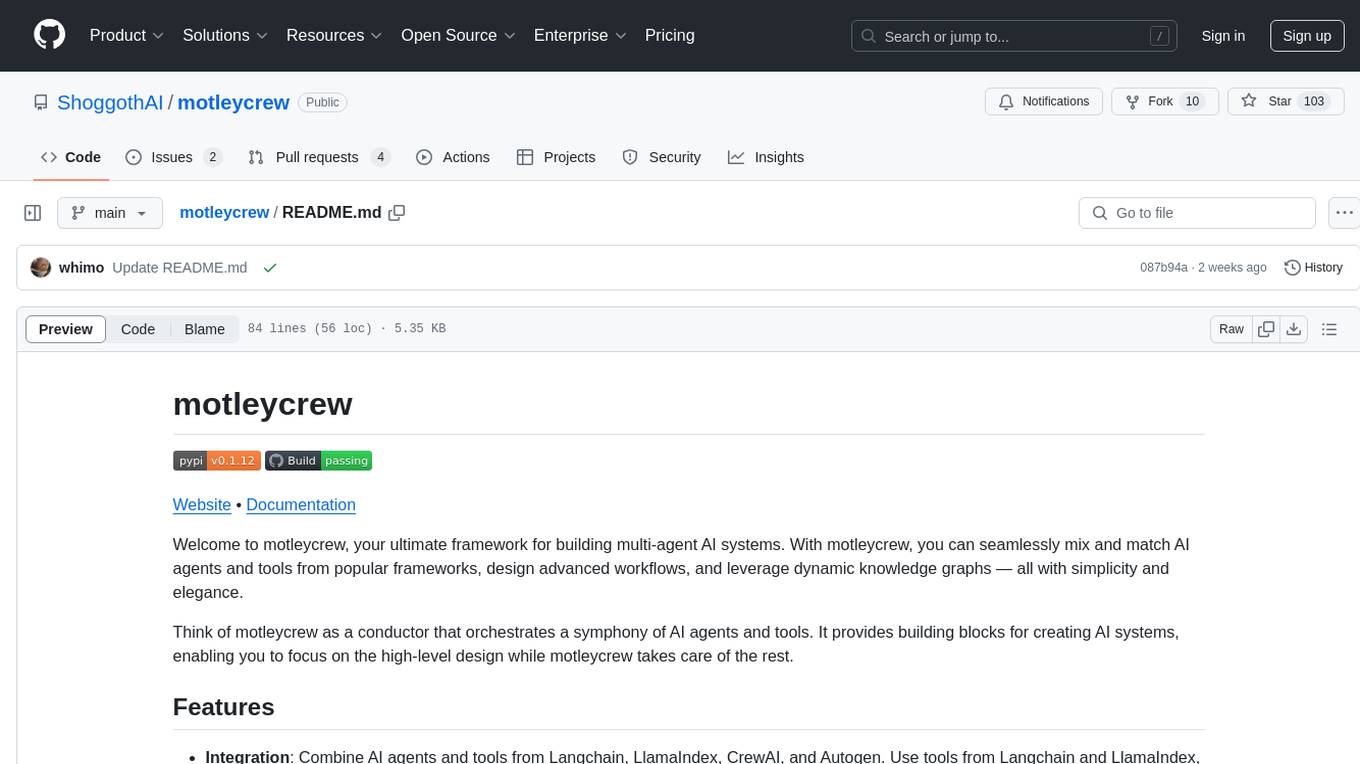
motleycrew
Motleycrew is an ultimate framework for building multi-agent AI systems, allowing users to mix and match AI agents and tools from popular frameworks, design advanced workflows, and leverage dynamic knowledge graphs with simplicity and elegance. It acts as a conductor orchestrating a symphony of AI agents and tools, providing building blocks for creating AI systems and enabling users to focus on high-level design while taking care of the rest. The framework offers integration with various tools, flexibility in providing agents with tools or other agents, advanced flow design capabilities, and built-in observability and caching features.
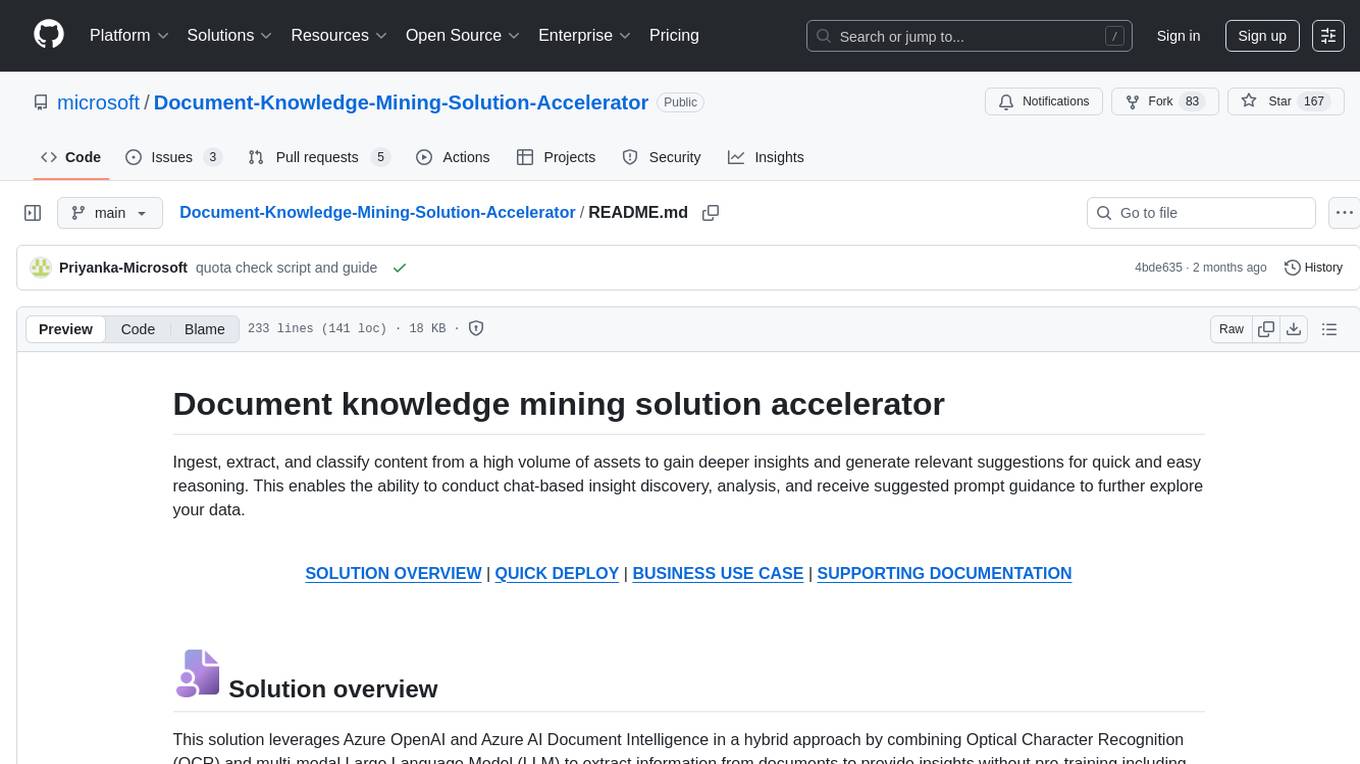
Document-Knowledge-Mining-Solution-Accelerator
The Document Knowledge Mining Solution Accelerator leverages Azure OpenAI and Azure AI Document Intelligence to ingest, extract, and classify content from various assets, enabling chat-based insight discovery, analysis, and prompt guidance. It uses OCR and multi-modal LLM to extract information from documents like text, handwritten text, charts, graphs, tables, and form fields. Users can customize the technical architecture and data processing workflow. Key features include ingesting and extracting real-world entities, chat-based insights discovery, text and document data analysis, prompt suggestion guidance, and multi-modal information processing.
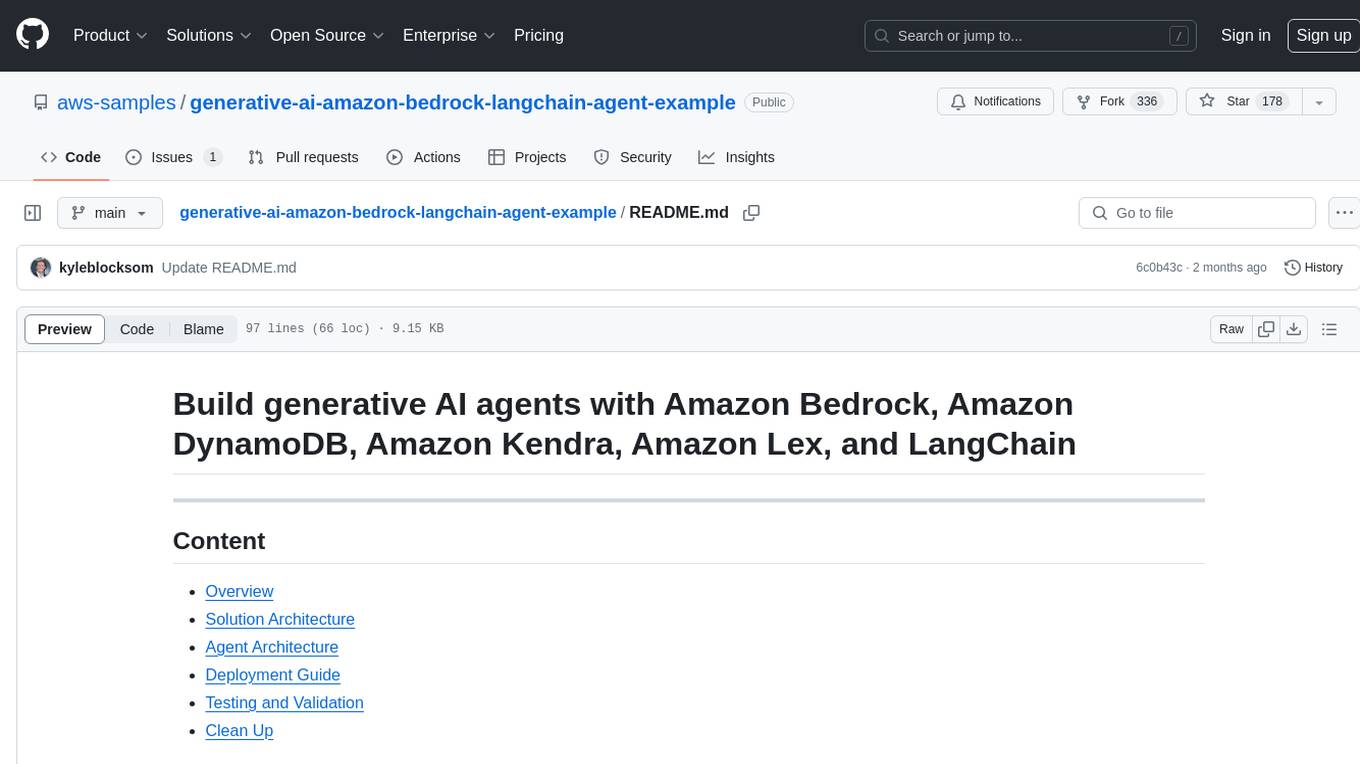
generative-ai-amazon-bedrock-langchain-agent-example
This repository provides a sample solution for building generative AI agents using Amazon Bedrock, Amazon DynamoDB, Amazon Kendra, Amazon Lex, and LangChain. The solution creates a generative AI financial services agent capable of assisting users with account information, loan applications, and answering natural language questions. It serves as a launchpad for developers to create personalized conversational agents for applications like chatbots and virtual assistants.
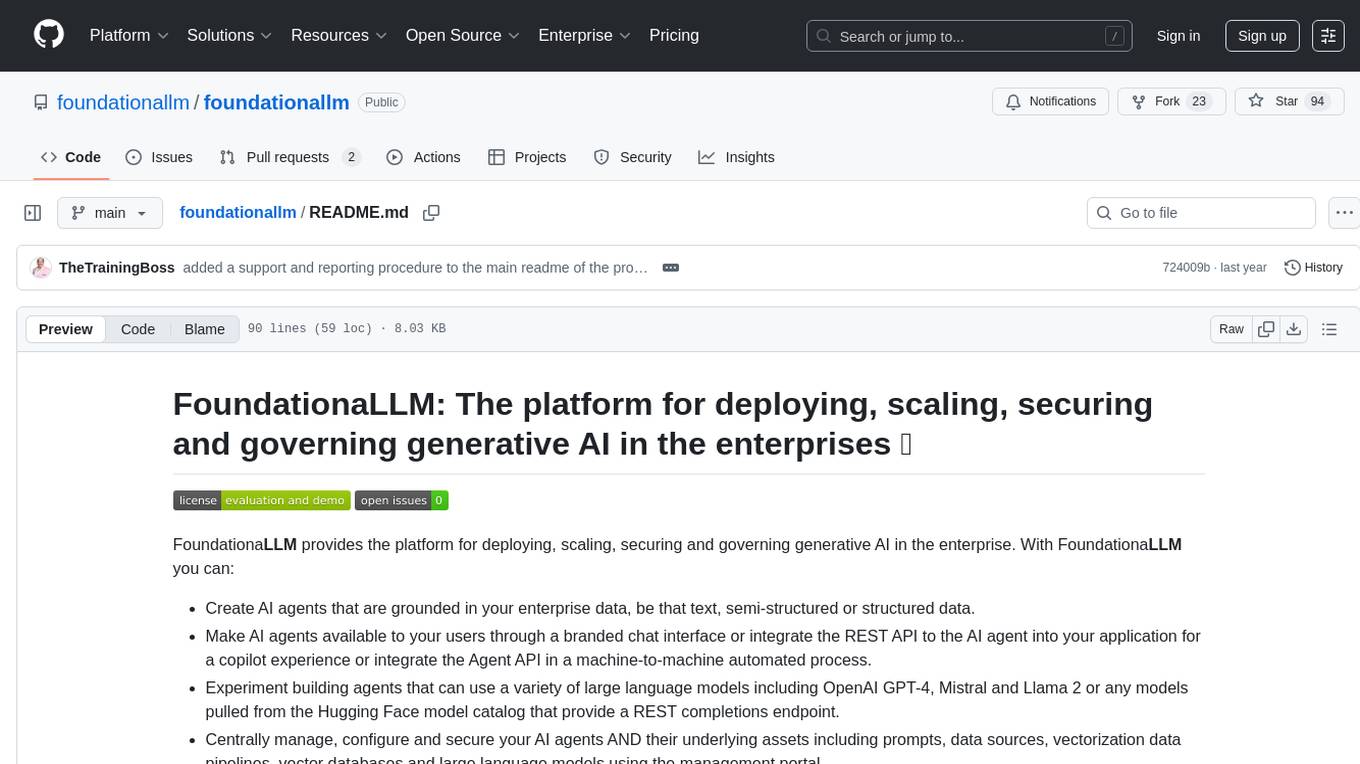
foundationallm
FoundationaLLM is a platform designed for deploying, scaling, securing, and governing generative AI in enterprises. It allows users to create AI agents grounded in enterprise data, integrate REST APIs, experiment with various large language models, centrally manage AI agents and their assets, deploy scalable vectorization data pipelines, enable non-developer users to create their own AI agents, control access with role-based access controls, and harness capabilities from Azure AI and Azure OpenAI. The platform simplifies integration with enterprise data sources, provides fine-grain security controls, scalability, extensibility, and addresses the challenges of delivering enterprise copilots or AI agents.
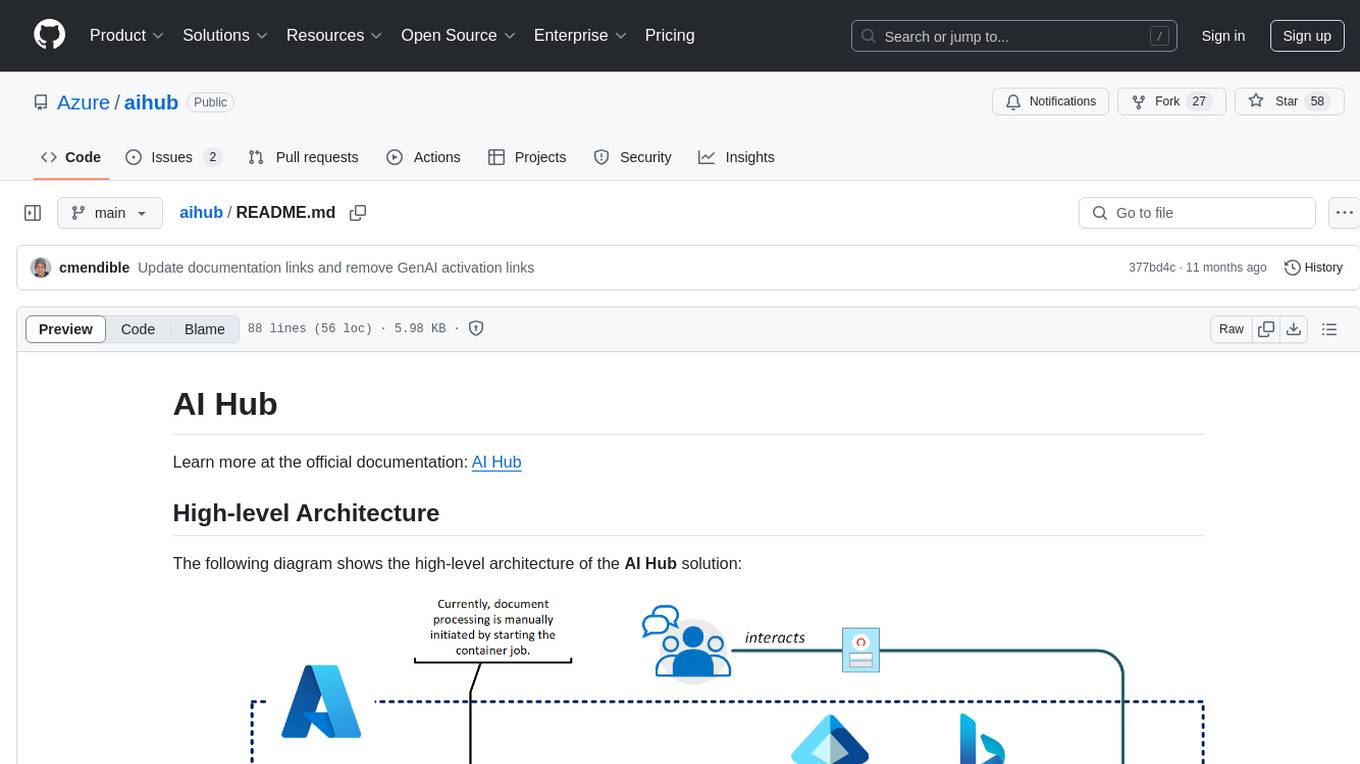
aihub
AI Hub is a comprehensive solution that leverages artificial intelligence and cloud computing to provide functionalities such as document search and retrieval, call center analytics, image analysis, brand reputation analysis, form analysis, document comparison, and content safety moderation. It integrates various Azure services like Cognitive Search, ChatGPT, Azure Vision Services, and Azure Document Intelligence to offer scalable, extensible, and secure AI-powered capabilities for different use cases and scenarios.
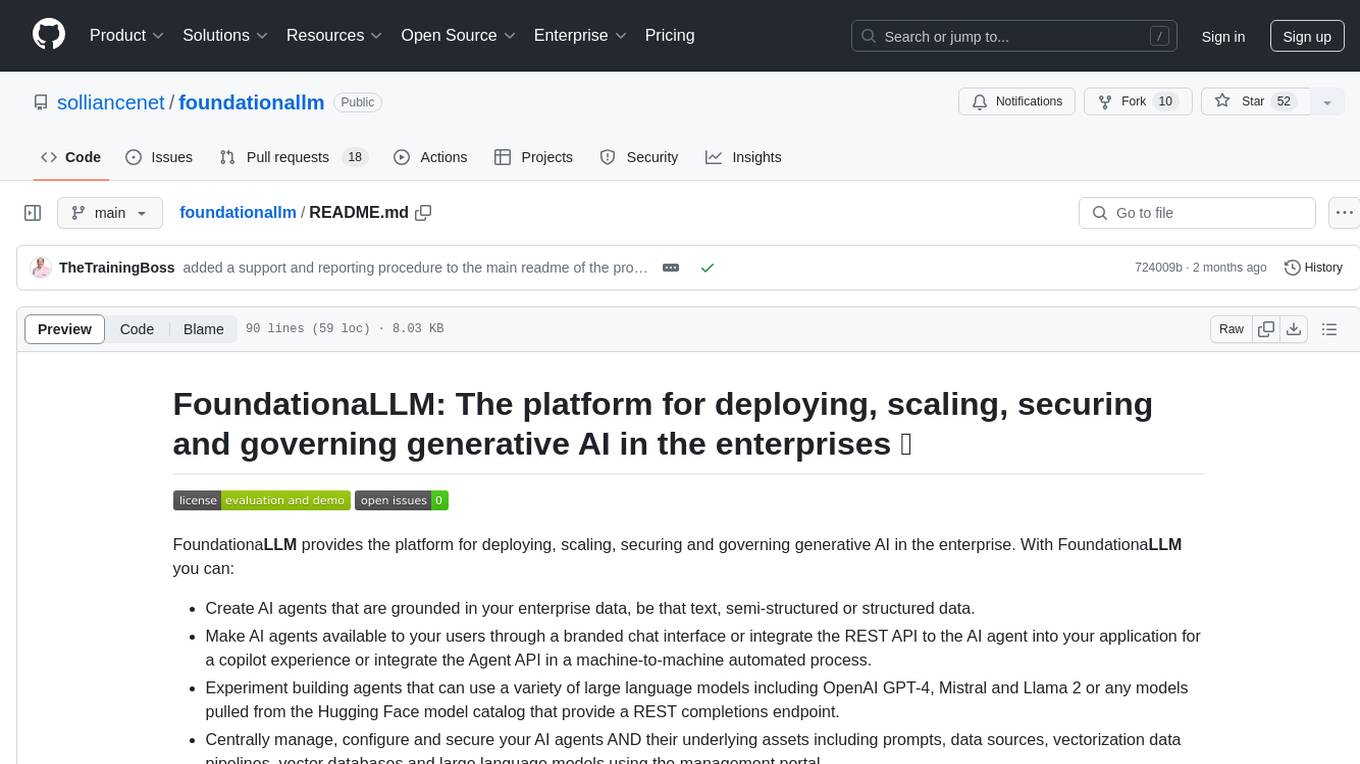
foundationallm
FoundationaLLM is a platform designed for deploying, scaling, securing, and governing generative AI in enterprises. It allows users to create AI agents grounded in enterprise data, integrate REST APIs, experiment with large language models, centrally manage AI agents and assets, deploy scalable vectorization data pipelines, enable non-developer users to create their own AI agents, control access with role-based access controls, and harness capabilities from Azure AI and Azure OpenAI. The platform simplifies integration with enterprise data sources, provides fine-grain security controls, load balances across multiple endpoints, and is extensible to new data sources and orchestrators. FoundationaLLM addresses the need for customized copilots or AI agents that are secure, licensed, flexible, and suitable for enterprise-scale production.
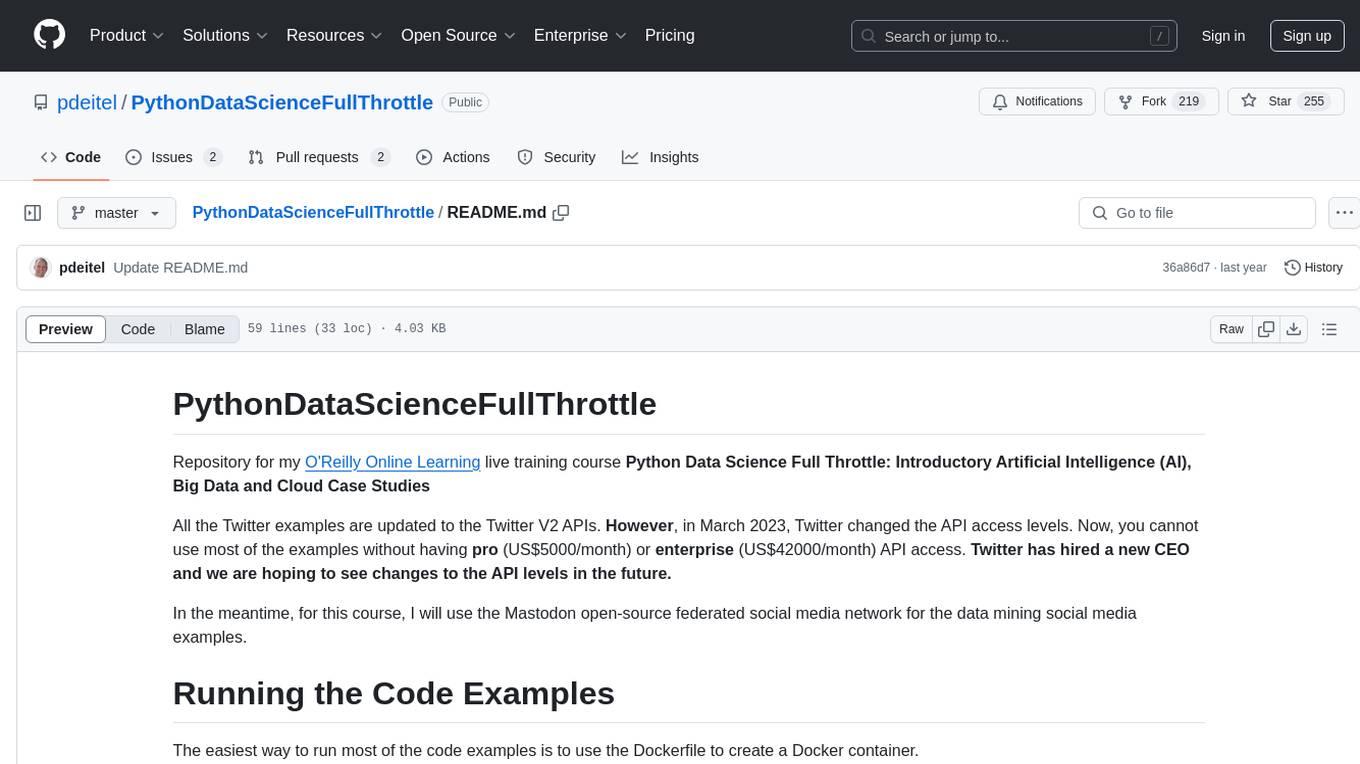
PythonDataScienceFullThrottle
PythonDataScienceFullThrottle is a comprehensive repository containing various Python scripts, libraries, and tools for data science enthusiasts. It includes a wide range of functionalities such as data preprocessing, visualization, machine learning algorithms, and statistical analysis. The repository aims to provide a one-stop solution for individuals looking to dive deep into the world of data science using Python.
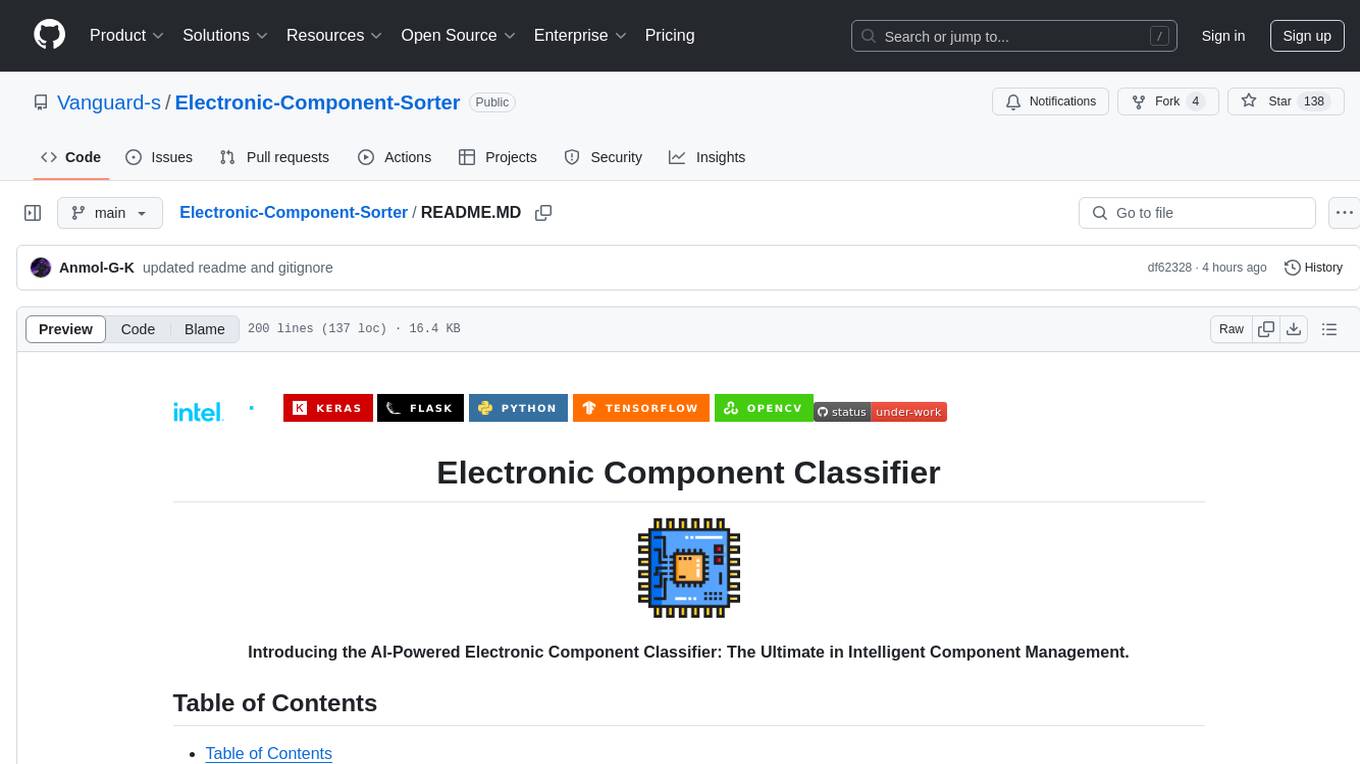
Electronic-Component-Sorter
The Electronic Component Classifier is a project that uses machine learning and artificial intelligence to automate the identification and classification of electrical and electronic components. It features component classification into seven classes, user-friendly design, and integration with Flask for a user-friendly interface. The project aims to reduce human error in component identification, make the process safer and more reliable, and potentially help visually impaired individuals in identifying electronic components.
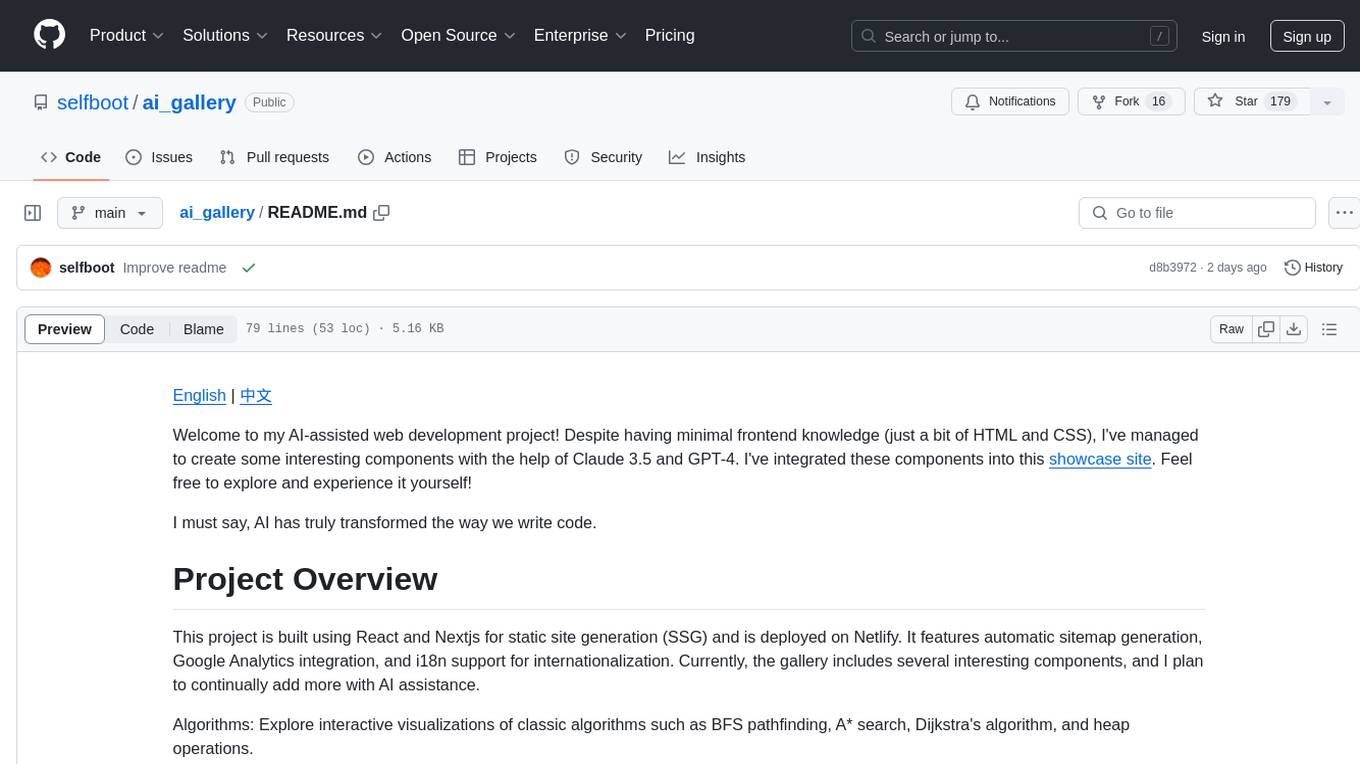
ai_gallery
AI Gallery is a showcase site built using React and Nextjs for static site generation, featuring interactive visualizations of classic algorithms, classic games implementation, and various interesting widgets. The project utilizes AI assistance from Claude 3.5 and GPT-4 to create components and enhance the development process. It aims to continually add more components with AI assistance, providing a platform for contributors to leverage AI in frontend development.
For similar tasks

LLMStack
LLMStack is a no-code platform for building generative AI agents, workflows, and chatbots. It allows users to connect their own data, internal tools, and GPT-powered models without any coding experience. LLMStack can be deployed to the cloud or on-premise and can be accessed via HTTP API or triggered from Slack or Discord.

ai-guide
This guide is dedicated to Large Language Models (LLMs) that you can run on your home computer. It assumes your PC is a lower-end, non-gaming setup.
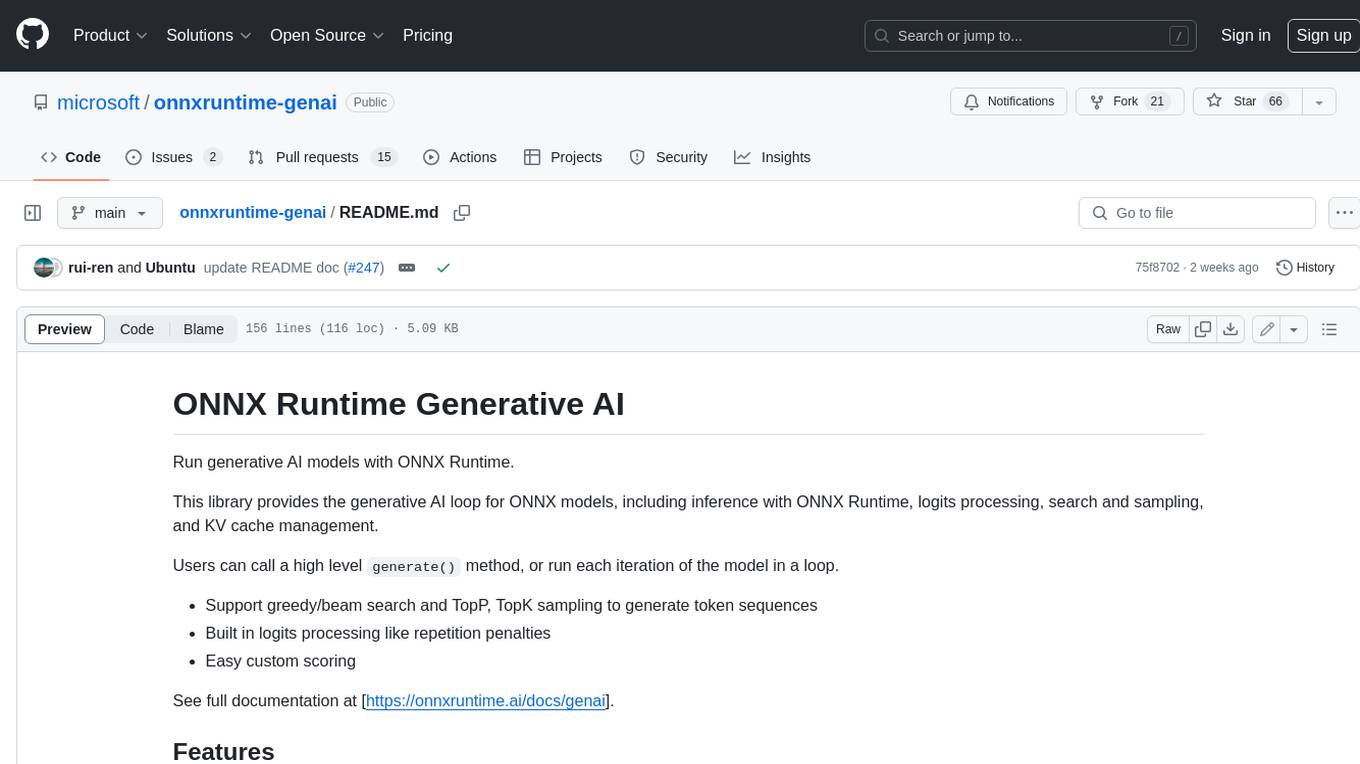
onnxruntime-genai
ONNX Runtime Generative AI is a library that provides the generative AI loop for ONNX models, including inference with ONNX Runtime, logits processing, search and sampling, and KV cache management. Users can call a high level `generate()` method, or run each iteration of the model in a loop. It supports greedy/beam search and TopP, TopK sampling to generate token sequences, has built in logits processing like repetition penalties, and allows for easy custom scoring.

jupyter-ai
Jupyter AI connects generative AI with Jupyter notebooks. It provides a user-friendly and powerful way to explore generative AI models in notebooks and improve your productivity in JupyterLab and the Jupyter Notebook. Specifically, Jupyter AI offers: * An `%%ai` magic that turns the Jupyter notebook into a reproducible generative AI playground. This works anywhere the IPython kernel runs (JupyterLab, Jupyter Notebook, Google Colab, Kaggle, VSCode, etc.). * A native chat UI in JupyterLab that enables you to work with generative AI as a conversational assistant. * Support for a wide range of generative model providers, including AI21, Anthropic, AWS, Cohere, Gemini, Hugging Face, NVIDIA, and OpenAI. * Local model support through GPT4All, enabling use of generative AI models on consumer grade machines with ease and privacy.
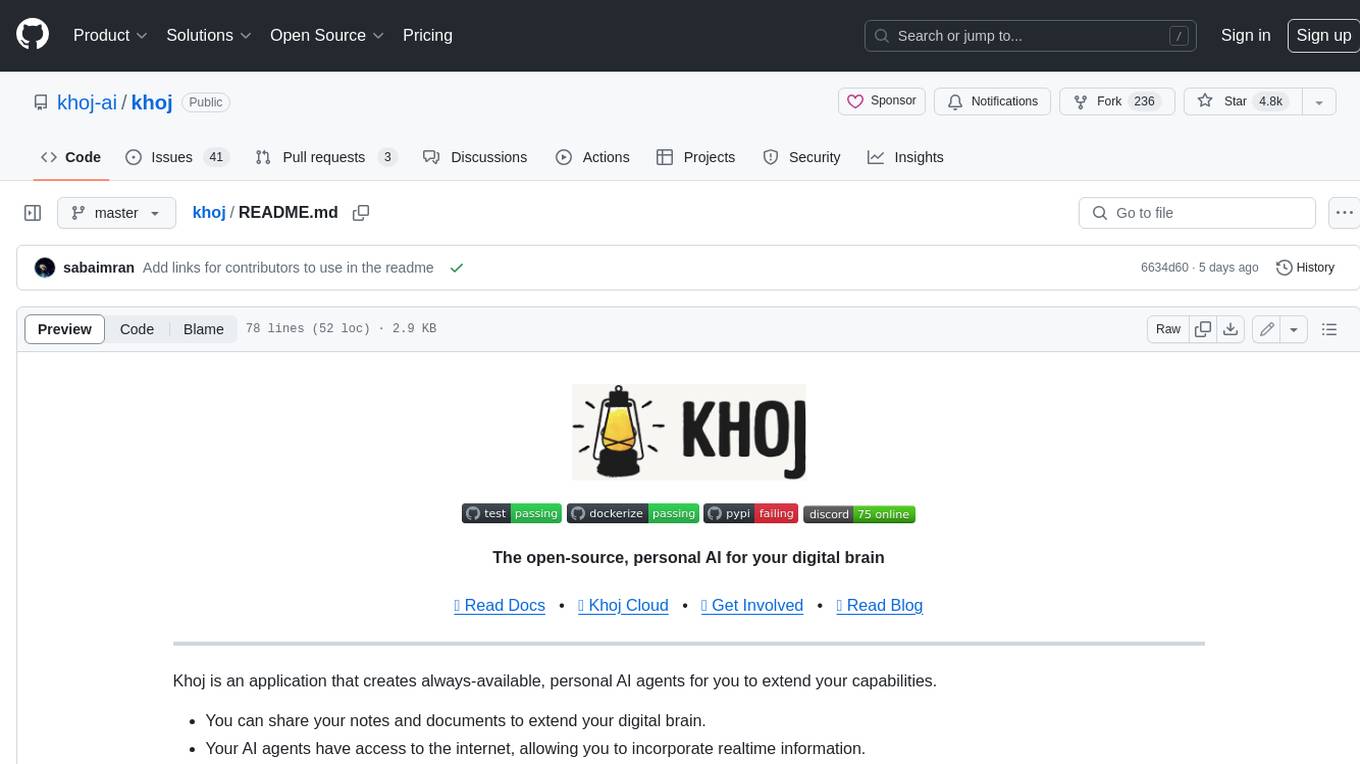
khoj
Khoj is an open-source, personal AI assistant that extends your capabilities by creating always-available AI agents. You can share your notes and documents to extend your digital brain, and your AI agents have access to the internet, allowing you to incorporate real-time information. Khoj is accessible on Desktop, Emacs, Obsidian, Web, and Whatsapp, and you can share PDF, markdown, org-mode, notion files, and GitHub repositories. You'll get fast, accurate semantic search on top of your docs, and your agents can create deeply personal images and understand your speech. Khoj is self-hostable and always will be.
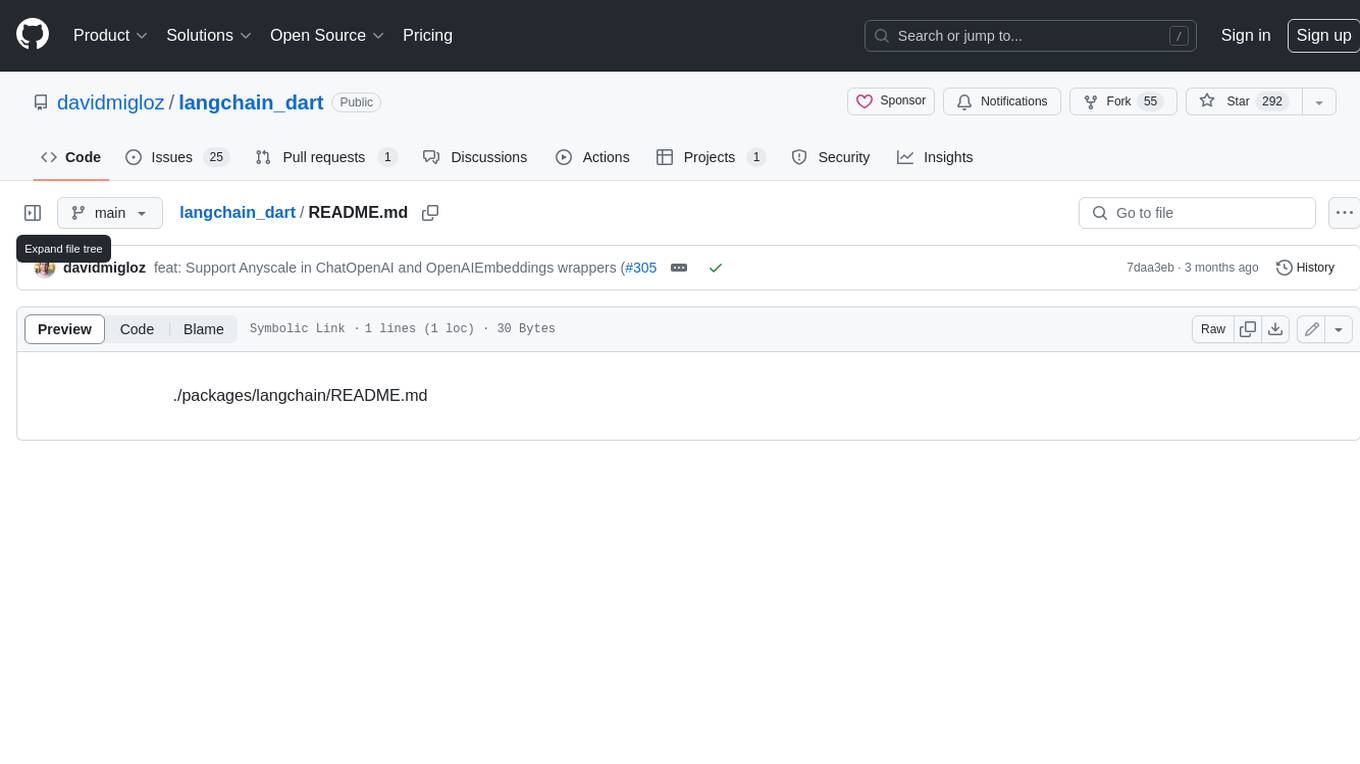
langchain_dart
LangChain.dart is a Dart port of the popular LangChain Python framework created by Harrison Chase. LangChain provides a set of ready-to-use components for working with language models and a standard interface for chaining them together to formulate more advanced use cases (e.g. chatbots, Q&A with RAG, agents, summarization, extraction, etc.). The components can be grouped into a few core modules: * **Model I/O:** LangChain offers a unified API for interacting with various LLM providers (e.g. OpenAI, Google, Mistral, Ollama, etc.), allowing developers to switch between them with ease. Additionally, it provides tools for managing model inputs (prompt templates and example selectors) and parsing the resulting model outputs (output parsers). * **Retrieval:** assists in loading user data (via document loaders), transforming it (with text splitters), extracting its meaning (using embedding models), storing (in vector stores) and retrieving it (through retrievers) so that it can be used to ground the model's responses (i.e. Retrieval-Augmented Generation or RAG). * **Agents:** "bots" that leverage LLMs to make informed decisions about which available tools (such as web search, calculators, database lookup, etc.) to use to accomplish the designated task. The different components can be composed together using the LangChain Expression Language (LCEL).
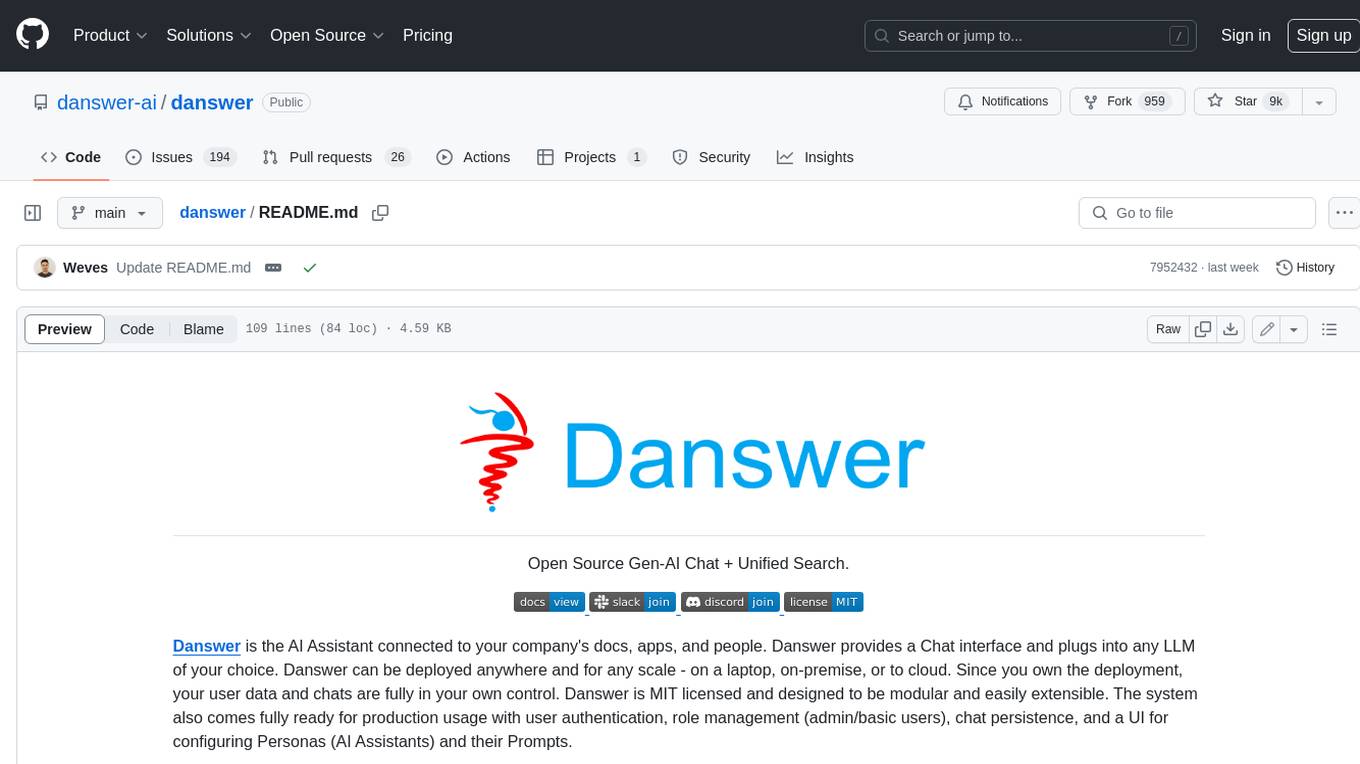
danswer
Danswer is an open-source Gen-AI Chat and Unified Search tool that connects to your company's docs, apps, and people. It provides a Chat interface and plugs into any LLM of your choice. Danswer can be deployed anywhere and for any scale - on a laptop, on-premise, or to cloud. Since you own the deployment, your user data and chats are fully in your own control. Danswer is MIT licensed and designed to be modular and easily extensible. The system also comes fully ready for production usage with user authentication, role management (admin/basic users), chat persistence, and a UI for configuring Personas (AI Assistants) and their Prompts. Danswer also serves as a Unified Search across all common workplace tools such as Slack, Google Drive, Confluence, etc. By combining LLMs and team specific knowledge, Danswer becomes a subject matter expert for the team. Imagine ChatGPT if it had access to your team's unique knowledge! It enables questions such as "A customer wants feature X, is this already supported?" or "Where's the pull request for feature Y?"

infinity
Infinity is an AI-native database designed for LLM applications, providing incredibly fast full-text and vector search capabilities. It supports a wide range of data types, including vectors, full-text, and structured data, and offers a fused search feature that combines multiple embeddings and full text. Infinity is easy to use, with an intuitive Python API and a single-binary architecture that simplifies deployment. It achieves high performance, with 0.1 milliseconds query latency on million-scale vector datasets and up to 15K QPS.
For similar jobs
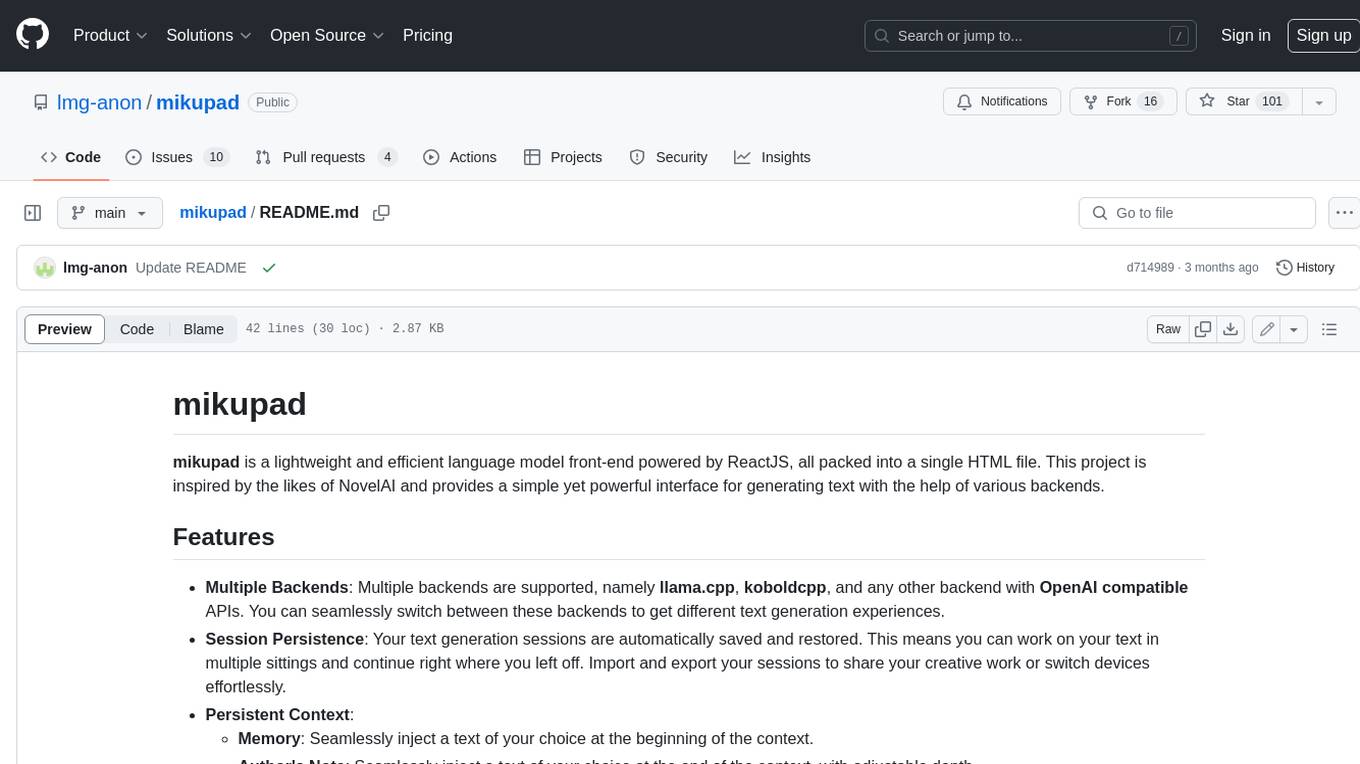
mikupad
mikupad is a lightweight and efficient language model front-end powered by ReactJS, all packed into a single HTML file. Inspired by the likes of NovelAI, it provides a simple yet powerful interface for generating text with the help of various backends.
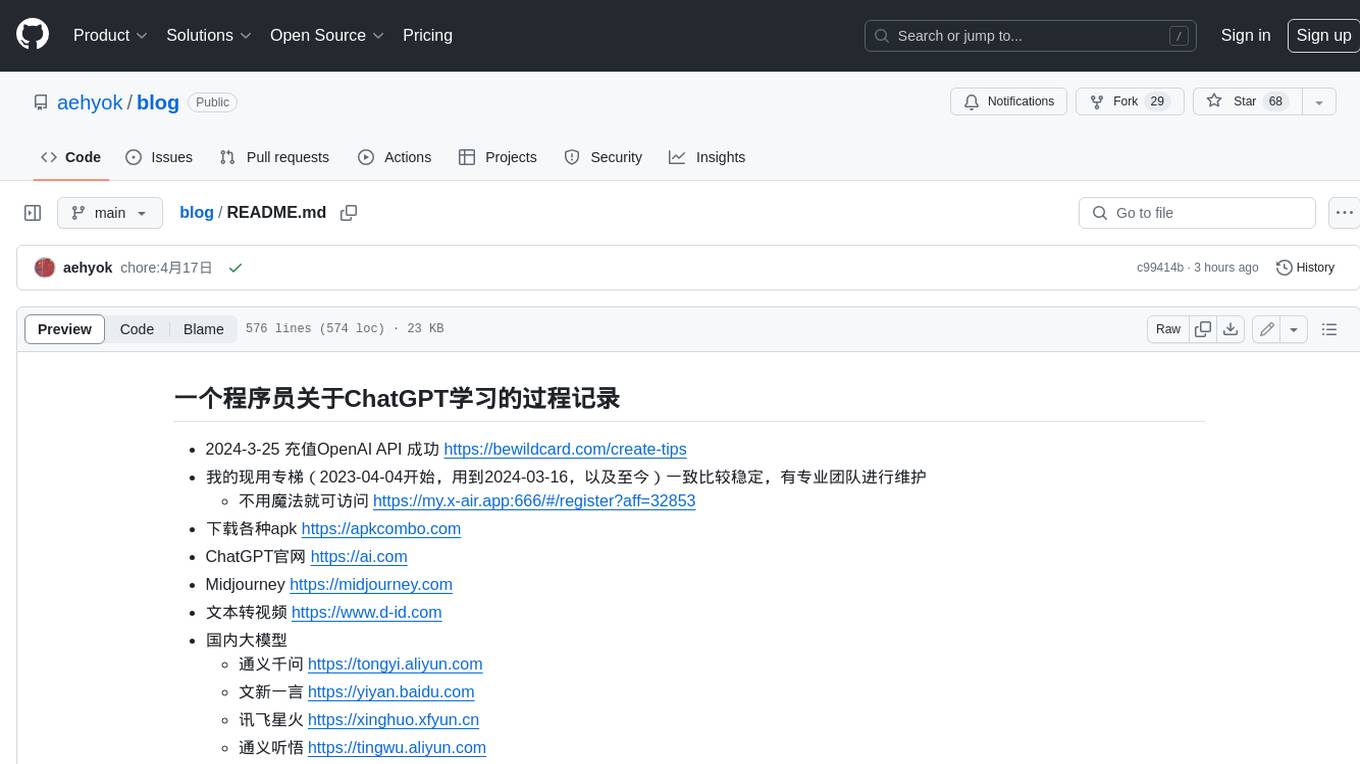
blog
这是一个程序员关于 ChatGPT 学习过程的记录,其中包括了 ChatGPT 的使用技巧、相关工具和资源的整理,以及一些个人见解和思考。 **使用技巧** * **充值 OpenAI API**:可以通过 https://beta.openai.com/account/api-keys 进行充值,支持信用卡和 PayPal。 * **使用专梯**:推荐使用稳定的专梯,可以有效提高 ChatGPT 的访问速度和稳定性。 * **使用魔法**:可以通过 https://my.x-air.app:666/#/register?aff=32853 访问 ChatGPT,无需魔法即可访问。 * **下载各种 apk**:可以通过 https://apkcombo.com 下载各种安卓应用的 apk 文件。 * **ChatGPT 官网**:ChatGPT 的官方网站是 https://ai.com。 * **Midjourney**:Midjourney 是一个生成式 AI 图像平台,可以通过 https://midjourney.com 访问。 * **文本转视频**:可以通过 https://www.d-id.com 将文本转换为视频。 * **国内大模型**:国内也有很多大模型,如阿里巴巴的通义千问、百度文心一言、讯飞星火、阿里巴巴通义听悟等。 * **查看 OpenAI 状态**:可以通过 https://status.openai.com/ 查看 OpenAI 的服务状态。 * **Canva 画图**:Canva 是一个在线平面设计平台,可以通过 https://www.canva.cn 进行画图。 **相关工具和资源** * **文字转语音**:可以通过 https://modelscope.cn/models?page=1&tasks=text-to-speech&type=audio 找到文字转语音的模型。 * **可好好玩玩的项目**: * https://github.com/sunner/ChatALL * https://github.com/labring/FastGPT * https://github.com/songquanpeng/one-api * **个人博客**: * https://baoyu.io/ * https://gorden-sun.notion.site/527689cd2b294e60912f040095e803c5?v=4f6cc12006c94f47aee4dc909511aeb5 * **srt 2 lrc 歌词**:可以通过 https://gotranscript.com/subtitle-converter 将 srt 格式的字幕转换为 lrc 格式的歌词。 * **5 种速率限制**:OpenAI API 有 5 种速率限制:RPM(每分钟请求数)、RPD(每天请求数)、TPM(每分钟 tokens 数量)、TPD(每天 tokens 数量)、IPM(每分钟图像数量)。 * **扣子平台**:coze.cn 是一个扣子平台,可以提供各种扣子。 * **通过云函数免费使用 GPT-3.5**:可以通过 https://juejin.cn/post/7353849549540589587 免费使用 GPT-3.5。 * **不蒜子 统计网页基数**:可以通过 https://busuanzi.ibruce.info/ 统计网页的基数。 * **视频总结和翻译网页**:可以通过 https://glarity.app/zh-CN 总结和翻译视频。 * **视频翻译和配音工具**:可以通过 https://github.com/jianchang512/pyvideotrans 翻译和配音视频。 * **文字生成音频**:可以通过 https://www.cnblogs.com/jijunjian/p/18118366 将文字生成音频。 * **memo ai**:memo.ac 是一个多模态 AI 平台,可以将视频链接、播客链接、本地音视频转换为文字,支持多语言转录后翻译,还可以将文字转换为新的音频。 * **视频总结工具**:可以通过 https://summarize.ing/ 总结视频。 * **可每天免费玩玩**:可以通过 https://www.perplexity.ai/ 每天免费玩玩。 * **Suno.ai**:Suno.ai 是一个 AI 语言模型,可以通过 https://bibigpt.co/ 访问。 * **CapCut**:CapCut 是一个视频编辑软件,可以通过 https://www.capcut.cn/ 下载。 * **Valla.ai**:Valla.ai 是一个多模态 AI 模型,可以通过 https://www.valla.ai/ 访问。 * **Viggle.ai**:Viggle.ai 是一个 AI 视频生成平台,可以通过 https://viggle.ai 访问。 * **使用免费的 GPU 部署文生图大模型**:可以通过 https://www.cnblogs.com/xuxiaona/p/18088404 部署文生图大模型。 * **语音转文字**:可以通过 https://speech.microsoft.com/portal 将语音转换为文字。 * **投资界的 ai**:可以通过 https://reportify.cc/ 了解投资界的 ai。 * **抓取小视频 app 的各种信息**:可以通过 https://github.com/NanmiCoder/MediaCrawler 抓取小视频 app 的各种信息。 * **马斯克 Grok1 开源**:马斯克的 Grok1 模型已经开源,可以通过 https://github.com/xai-org/grok-1 访问。 * **ChatALL**:ChatALL 是一个跨端支持的聊天机器人,可以通过 https://github.com/sunner/ChatALL 访问。 * **零一万物**:零一万物是一个 AI 平台,可以通过 https://www.01.ai/cn 访问。 * **智普**:智普是一个 AI 语言模型,可以通过 https://chatglm.cn/ 访问。 * **memo ai 下载**:可以通过 https://memo.ac/ 下载 memo ai。 * **ffmpeg 学习**:可以通过 https://www.ruanyifeng.com/blog/2020/01/ffmpeg.html 学习 ffmpeg。 * **自动生成文章小工具**:可以通过 https://www.cognition-labs.com/blog 生成文章。 * **简易商城**:可以通过 https://www.cnblogs.com/whuanle/p/18086537 搭建简易商城。 * **物联网**:可以通过 https://www.cnblogs.com/xuxiaona/p/18088404 学习物联网。 * **自定义表单、自定义列表、自定义上传和下载、自定义流程、自定义报表**:可以通过 https://www.cnblogs.com/whuanle/p/18086537 实现自定义表单、自定义列表、自定义上传和下载、自定义流程、自定义报表。 **个人见解和思考** * ChatGPT 是一个强大的工具,可以用来提高工作效率和创造力。 * ChatGPT 的使用门槛较低,即使是非技术人员也可以轻松上手。 * ChatGPT 的发展速度非常快,未来可能会对各个行业产生深远的影响。 * 我们应该理性看待 ChatGPT,既要看到它的优点,也要意识到它的局限性。 * 我们应该积极探索 ChatGPT 的应用场景,为社会创造价值。
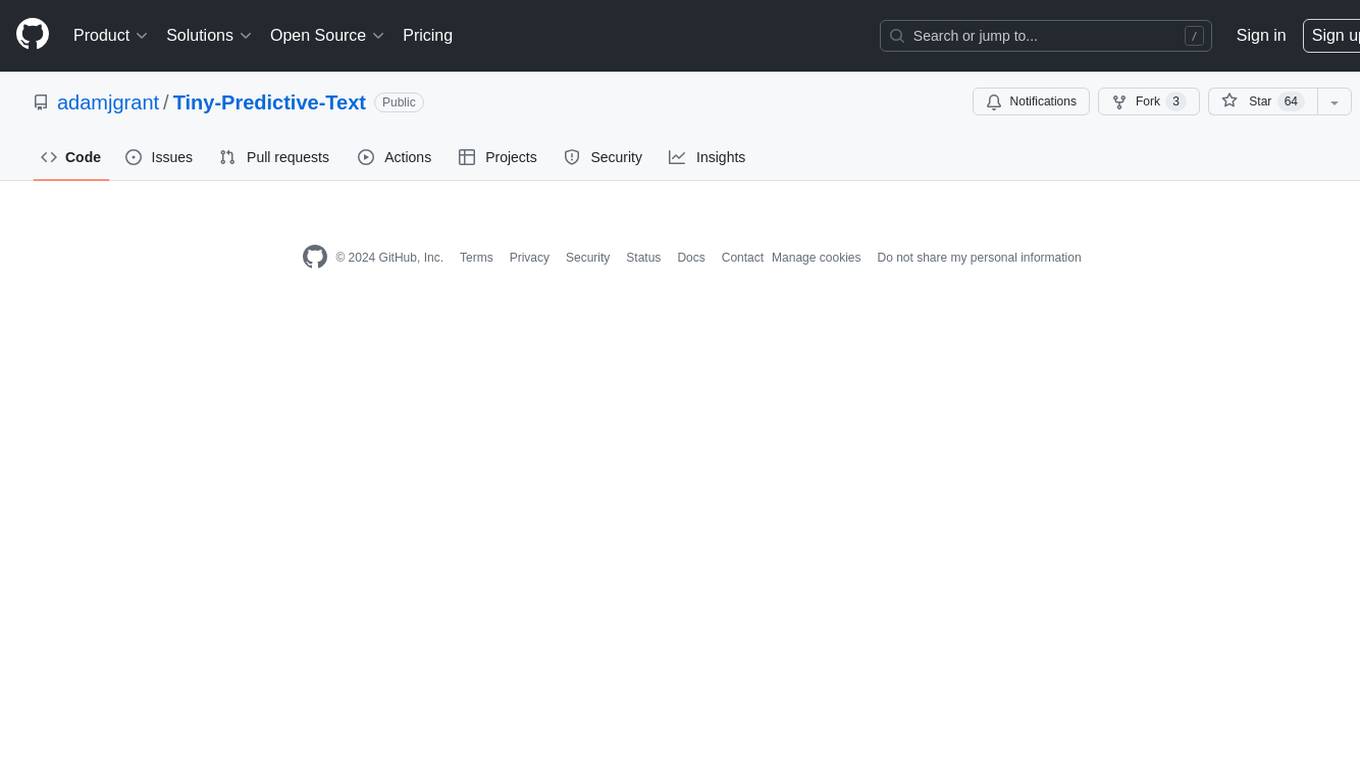
Tiny-Predictive-Text
Tiny-Predictive-Text is a demonstration of predictive text without an LLM, using permy.link. It provides a detailed description of the tool, including its features, benefits, and how to use it. The tool is suitable for a variety of jobs, including content writers, editors, and researchers. It can be used to perform a variety of tasks, such as generating text, completing sentences, and correcting errors.
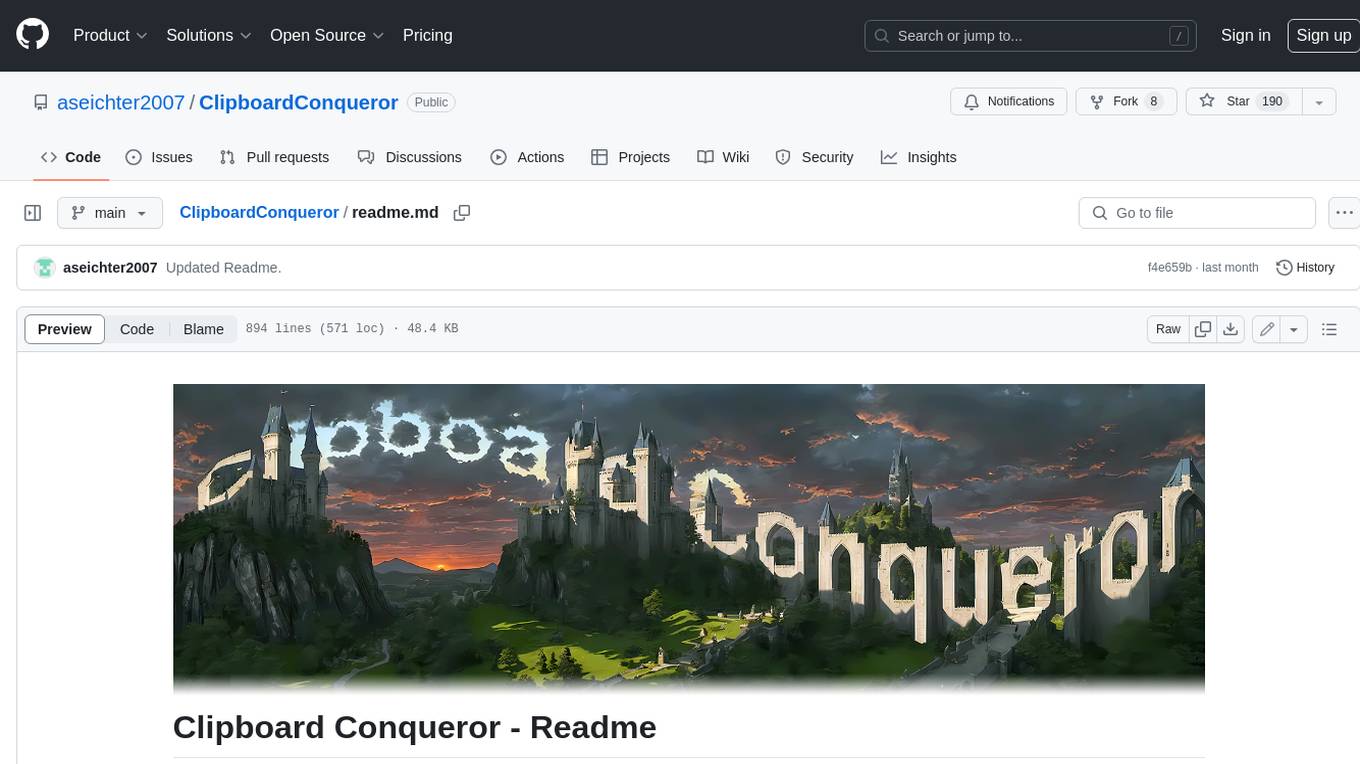
ClipboardConqueror
Clipboard Conqueror is a multi-platform omnipresent copilot alternative. Currently requiring a kobold united or openAI compatible back end, this software brings powerful LLM based tools to any text field, the universal copilot you deserve. It simply works anywhere. No need to sign in, no required key. Provided you are using local AI, CC is a data secure alternative integration provided you trust whatever backend you use. *Special thank you to the creators of KoboldAi, KoboldCPP, llamma, openAi, and the communities that made all this possible to figure out.
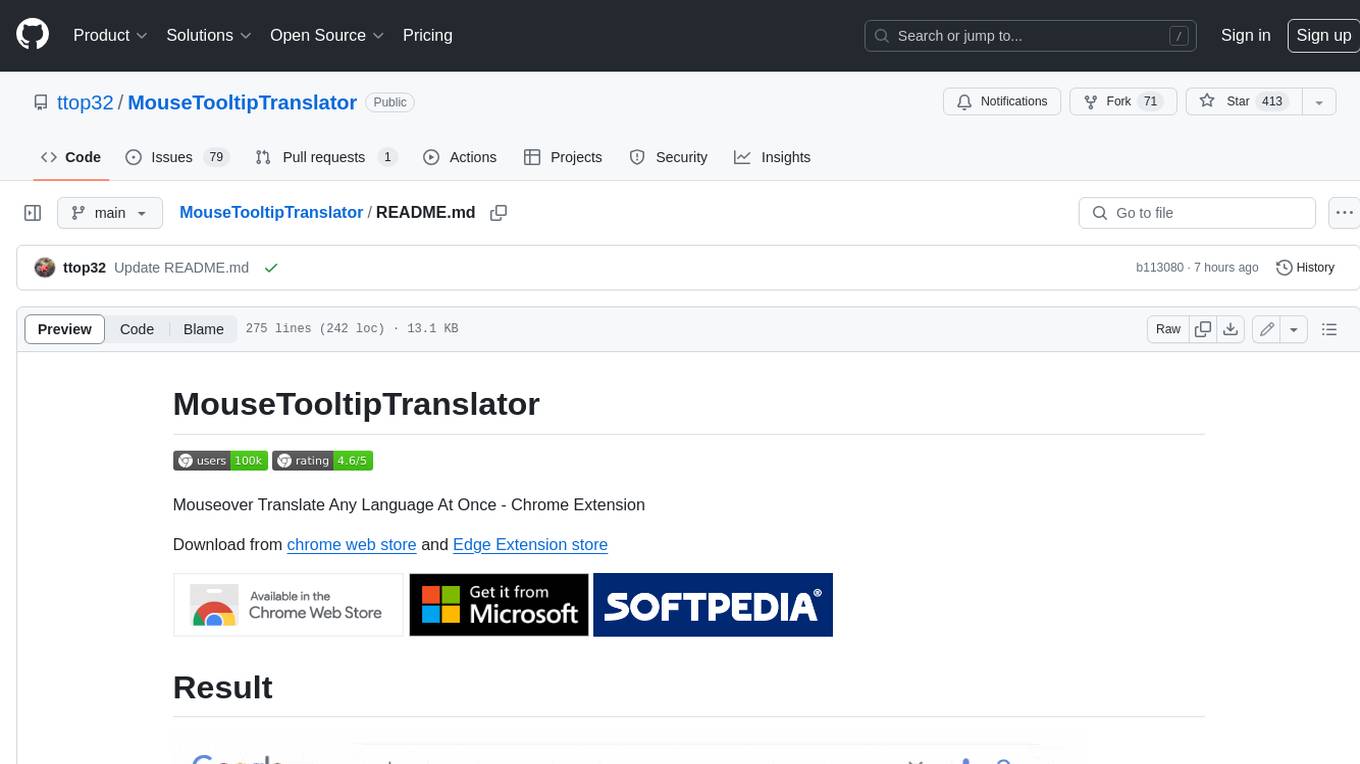
MouseTooltipTranslator
MouseTooltipTranslator is a Chrome extension that allows users to translate any text on a webpage by simply hovering over it. It supports both Google Translate and Bing Translate, and can also be used to listen to the pronunciation of words and phrases. Additionally, the extension can be used to translate text in input boxes and highlighted text, and to display translated tooltips for PDFs and YouTube videos. It also supports OCR, allowing users to translate text in images by holding down the left shift key and hovering over the image.
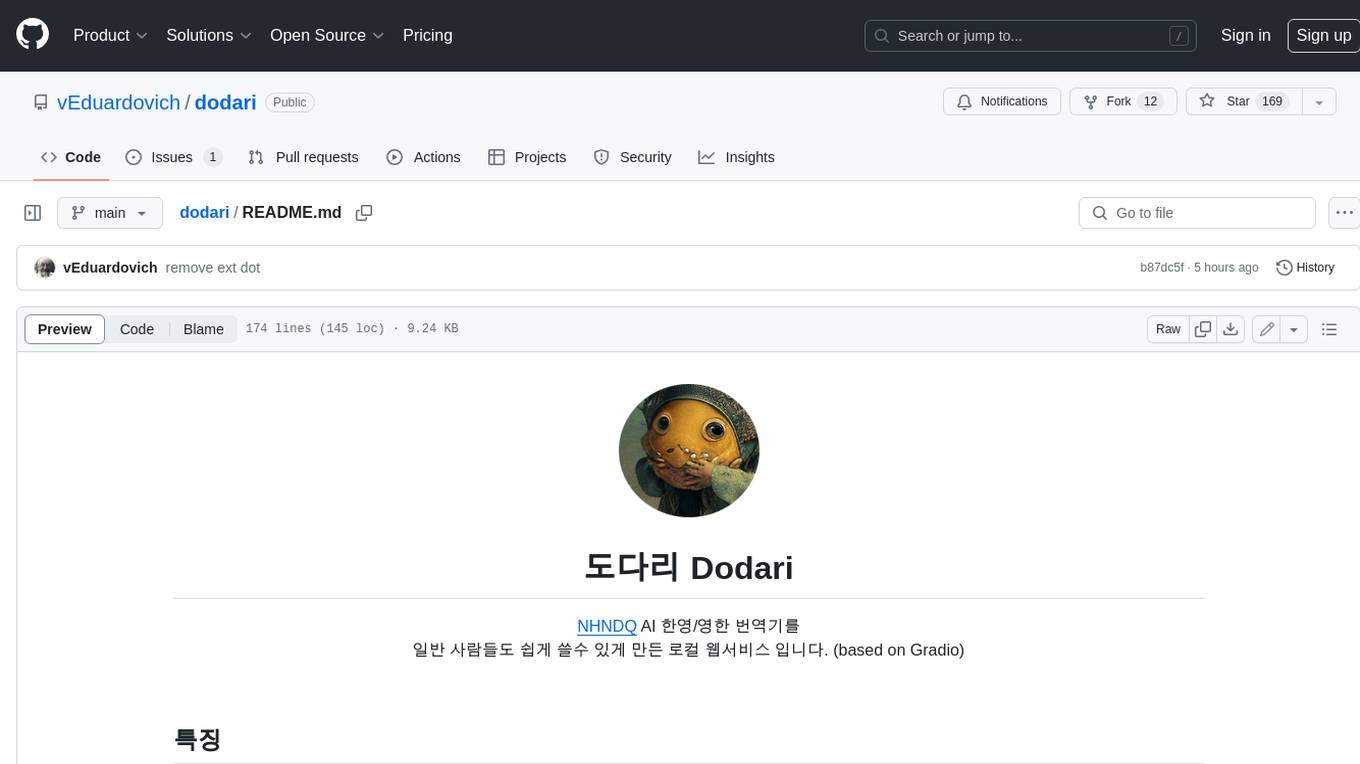
dodari
Dodari is a local web service that makes NHNDQ AI Korean-English/English-Korean translation easy for everyday people to use (based on Gradio).

gpt_academic
GPT Academic is a powerful tool that leverages the capabilities of large language models (LLMs) to enhance academic research and writing. It provides a user-friendly interface that allows researchers, students, and professionals to interact with LLMs and utilize their abilities for various academic tasks. With GPT Academic, users can access a wide range of features and functionalities, including: * **Summarization and Paraphrasing:** GPT Academic can summarize complex texts, articles, and research papers into concise and informative summaries. It can also paraphrase text to improve clarity and readability. * **Question Answering:** Users can ask GPT Academic questions related to their research or studies, and the tool will provide comprehensive and well-informed answers based on its knowledge and understanding of the relevant literature. * **Code Generation and Explanation:** GPT Academic can generate code snippets and provide explanations for complex coding concepts. It can also help debug code and suggest improvements. * **Translation:** GPT Academic supports translation of text between multiple languages, making it a valuable tool for researchers working with international collaborations or accessing resources in different languages. * **Citation and Reference Management:** GPT Academic can help users manage their citations and references by automatically generating citations in various formats and providing suggestions for relevant references based on the user's research topic. * **Collaboration and Note-Taking:** GPT Academic allows users to collaborate on projects and take notes within the tool. They can share their work with others and access a shared workspace for real-time collaboration. * **Customizable Interface:** GPT Academic offers a customizable interface that allows users to tailor the tool to their specific needs and preferences. They can choose from a variety of themes, adjust the layout, and add or remove features to create a personalized workspace. Overall, GPT Academic is a versatile and powerful tool that can significantly enhance the productivity and efficiency of academic research and writing. It empowers users to leverage the capabilities of LLMs and unlock new possibilities for academic exploration and knowledge creation.

Chinese-LLaMA-Alpaca-2
Chinese-LLaMA-Alpaca-2 is a large Chinese language model developed by Meta AI. It is based on the Llama-2 model and has been further trained on a large dataset of Chinese text. Chinese-LLaMA-Alpaca-2 can be used for a variety of natural language processing tasks, including text generation, question answering, and machine translation. Here are some of the key features of Chinese-LLaMA-Alpaca-2: * It is the largest Chinese language model ever trained, with 13 billion parameters. * It is trained on a massive dataset of Chinese text, including books, news articles, and social media posts. * It can be used for a variety of natural language processing tasks, including text generation, question answering, and machine translation. * It is open-source and available for anyone to use. Chinese-LLaMA-Alpaca-2 is a powerful tool that can be used to improve the performance of a wide range of natural language processing tasks. It is a valuable resource for researchers and developers working in the field of artificial intelligence.












